Since the beginning of civilisation and until the end of time, we will be able to count on change. An incredibly intelligent gentleman, Mr. Paul MacCready pointed out how we all kind of move along in time, in our own little 50-year bubbles of perspective. Because of this, it’s often hard to understand just how much the world has changed. In the battle of Nature vs. Mankind, it seems like humans won a long time ago.
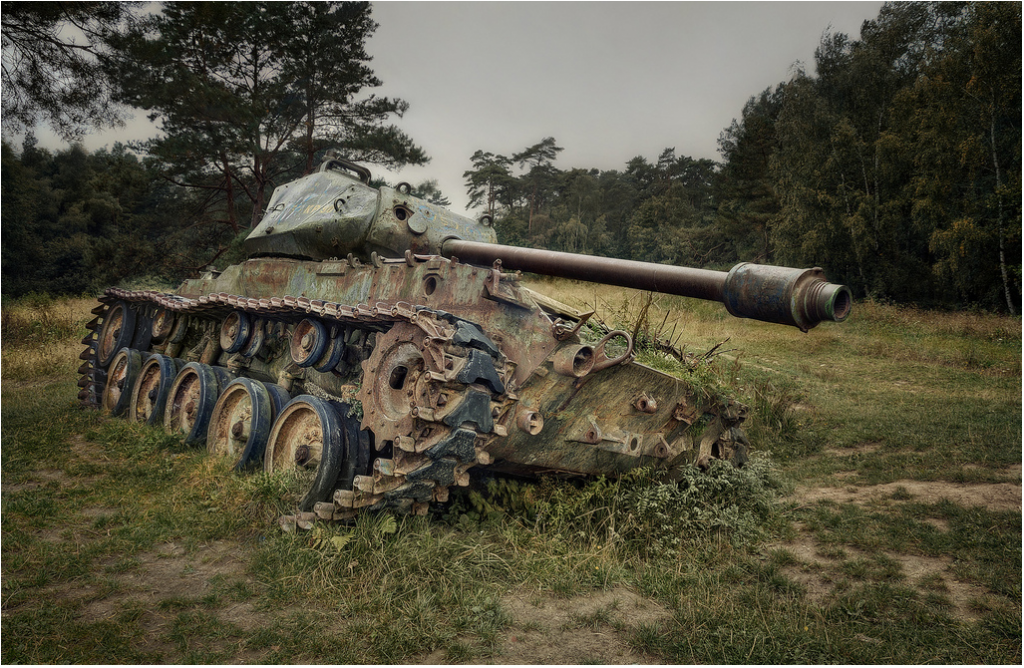
Photo courtesy of DARKstyle Pictures © Image subject to Copyright
But the war is far from over, and Mother Nature is striking back, reclaiming what’s hers. As humanity continues working towards a balanced, sustainable future, check out some of the haunting, ethereal landscapes that nature is taking back and making her own. We challenge you to find creepier!
Let us know what you think in the comments below.
Chernobyl Nuclear Disaster of 1986 – Ukraine (former Ukrainian SSR, Soviet Union)
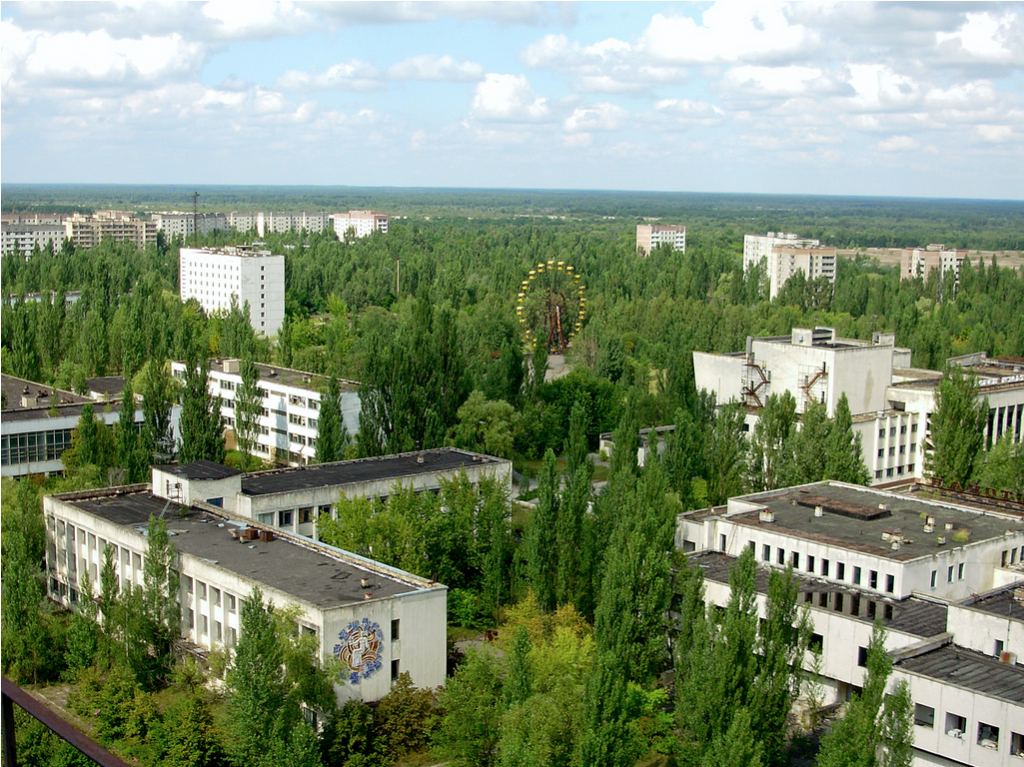
Photo courtesy of Slumbernaut © Image subject to Copyright
The worst disasters in history happen at the hands of humankind, and the Chernobyl accident is no exception. The Chernobyl disaster was one of only two nuclear accidents classified at the maximum level of 7 on the International Nuclear Event Scale. It began during an ordinary systems test at the Chernobyl Nuclear Power Plant on April 26, 1986, when an incredible power surge led to a series of explosions and fire in one of the reactors. A radioactive plume spewed into the atmosphere and spread through the air over Europe and the USSR, the long-term effects of which are still being investigated. Thirty-one people died directly from the accident. However, there have been numerous illnesses and related deaths in the decades since.
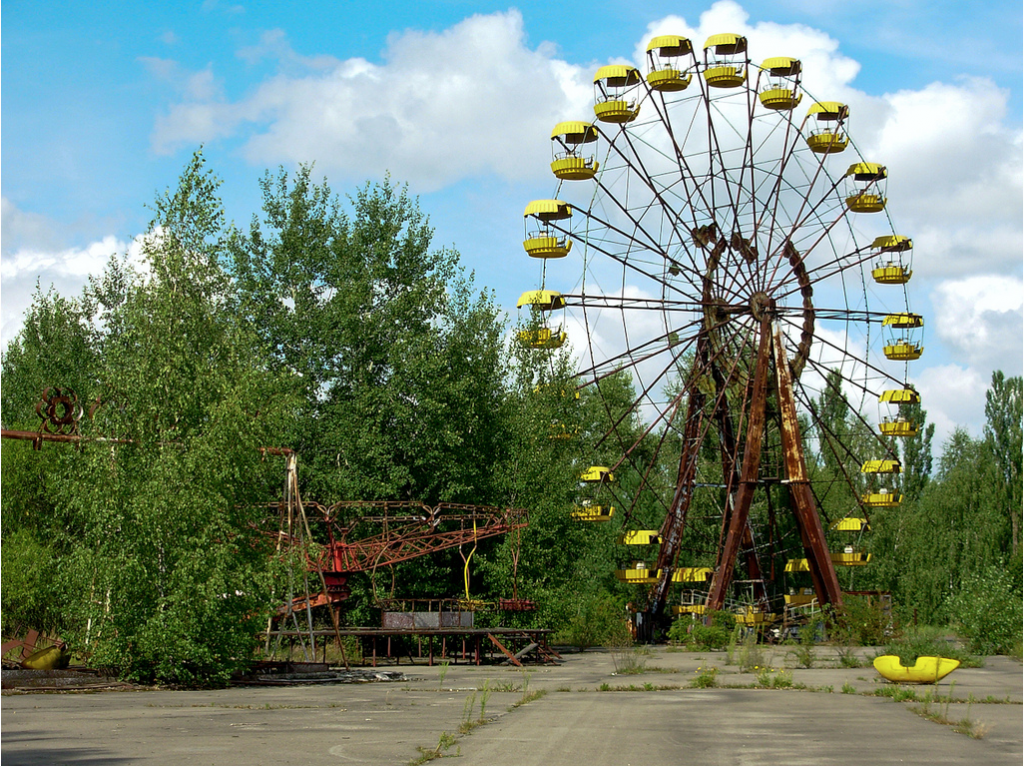
Photo courtesy of Slumbernaut © Image subject to Copyright
Nearby cities were not evacuated until more than twenty-four hours after the explosion when hundreds of people became sick with radiation poisoning. Once the exodus began, the cities became ghost towns, ghost towns whose buildings still stand as they were left. In many cases, there are still meals, toys, and the spooky remnants of lives interrupted and destroyed.
Meltdown at the Fukushima Daiichi Power Plant – 2011, Japan
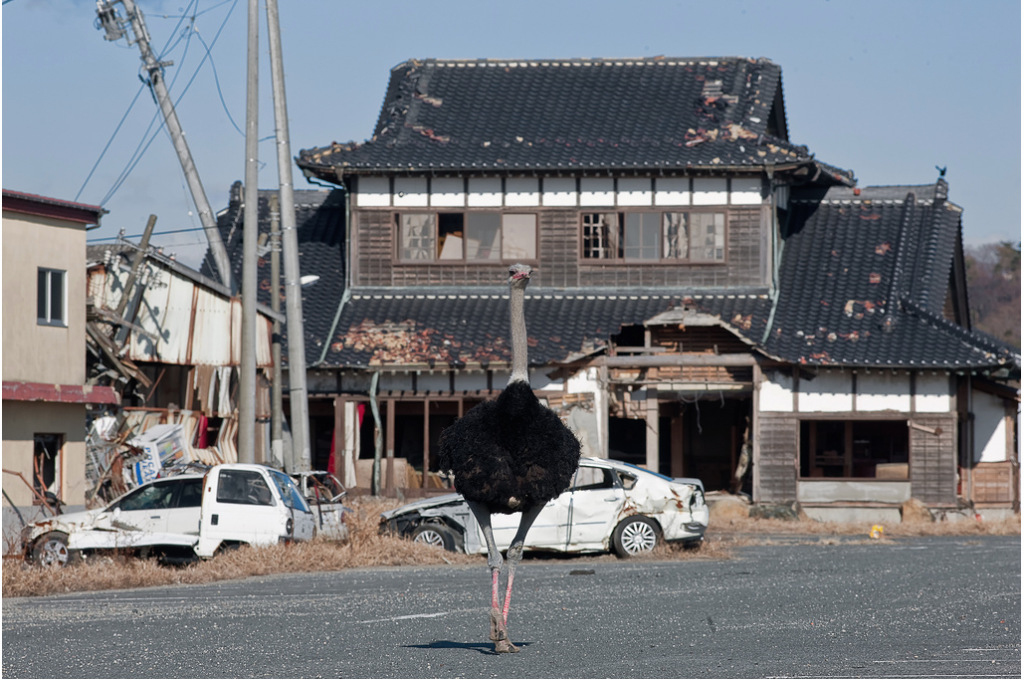
Photo courtesy of Osakabe Yasuo © Image subject to Copyright
The Fukushima Daiichi power plant meltdown happened when an earthquake and freak tsunami combined, causing the nuclear power station’s cooling towers to lose control and three of them to melt down within a couple days. The earthquake alone killed nearly twenty thousand people – it even moved the entire island country east. One hundred and sixty thousand more were evacuated and still live displaced. The city is frozen in time, buildings warped into roller coasters by the earthquake, gardens and rice paddies reverting to their wild nature, and abandoned pets-turned-feral wandering the streets.
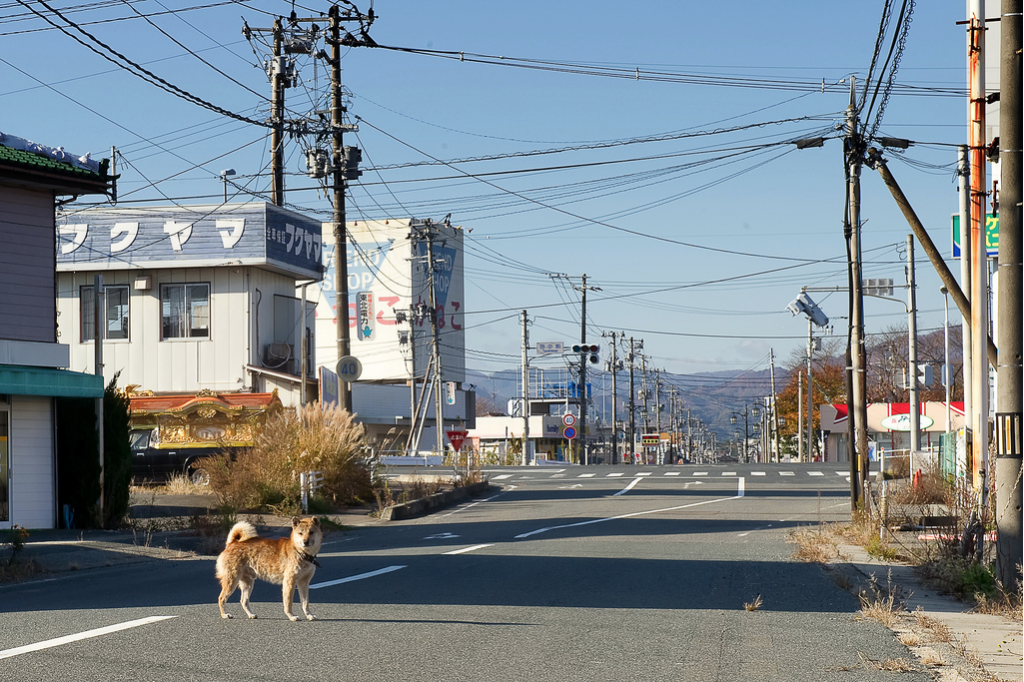
Photo courtesy of Osakabe Yasuo © Image subject to Copyright
Eleven municipalities were labelled as “no-go” zones by the Japanese government, and a 20-kilometer exclusion zone was created. The government allows adults to return to the disaster site on daily passes just once a month to clear their homes, and try and salvage what’s left. Children under the age of fifteen are not allowed back in the town. Whereas nature has begun to reclaim other nuclear and natural disaster sites, Fukushima and the town of Futaba have just begun their transformation. There is still no technology that exists today to approach the highly radioactive reactors’ core, and may not be for years or decades to come.
Oradour-sur-Glane – Haute-Vienne, France, 1944
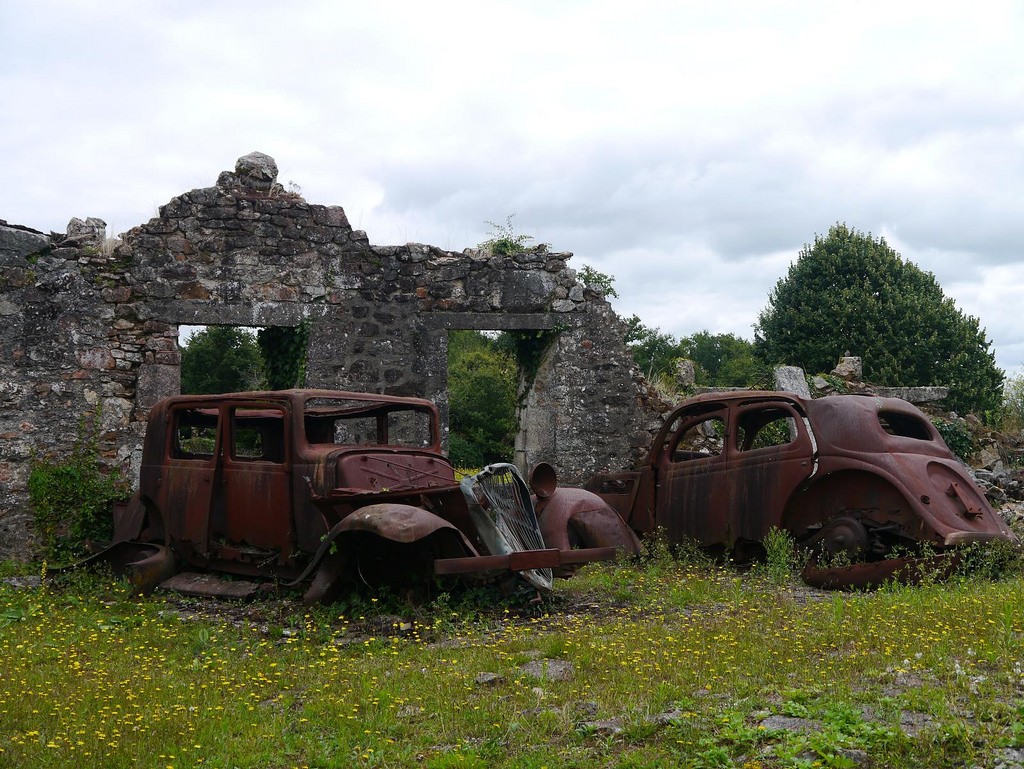
Photo courtesy of Carves Sud © Image subject to Copyright
Some of the most victorious reclamations of nature happen in an attempt to heal true human atrocities, like the massacre of 642 men, women and children at Oradour-sur-Glane in Nazi-occupied France. The war crime occurred June 10, 1944, when an SS officer and his battalion ordered the village people— and anyone happening by that day— into assembling in the town’s square under the assumption they’d have their identity papers examined. What happened next was one of the more gruesome massacres at the hands of the Nazi regime. There was only one survivor.

Photo courtesy of Carves Sud © Image subject to Copyright
A new village was constructed, but French President Charles de Gaulle decreed that the original vplantsillage be memorialised and permanently maintained as a museum. The village was burned and razed, but old iron sewing machines stand juxtaposed against crumbling rubble. Where stained glass is missing from church windows there now grows flowers and foliage; climbing ivy and mosses growing up rock faces and softening the shattered edges of what used to be walls. Metal table frames and chairs seem to sprout from the ground of their own accord while the earth slowly swallows rusted-out old cars; truly beautiful sights that visitors will not soon forget.
Abandoned Farms & Rural Homesteads – Ellis County, Texas
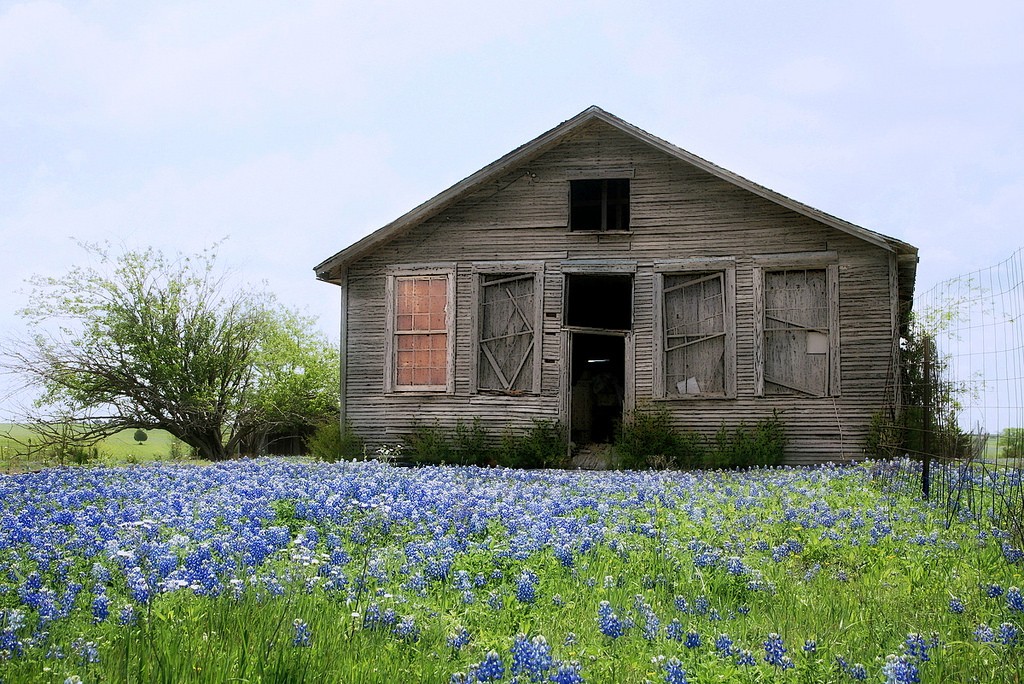
Photo courtesy of Ken Slade © Image subject to Copyright
Abandoned homes and rural properties are some of the most intriguing sights to behold. Along what’s known as the Bluebonnet Trail in the rural north Texas town of Ennis, the state flower stands proudly amidst Indian Paintbrushes for a short period once every year. If the climate is optimal, blooms of Bluebonnets will begin to appear in mid-April, scattered among rusty old farm equipment in bursts of cornflower blue. But like many other flowers you’ll see in this list, the Bluebonnet relies on its natural ecosystem, which has been less than optimal throughout recent years.
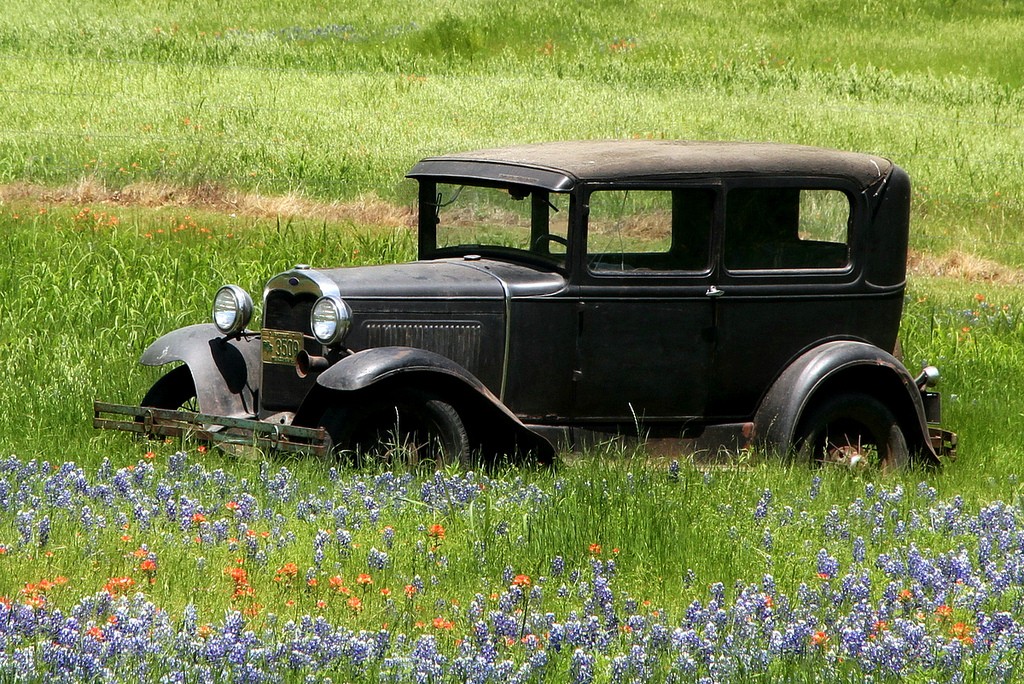
Photo courtesy of Ken Slade © Image subject to Copyright
We can’t help but wonder why the homes sit still, boarded up, with all the beauty around them. In many cases, inside the old farm houses there’s still furniture placed with care, and artwork hung on the walls. Right outside of the technology epicentre known as Silicon Valley, a different picture is painted with the yellow acres of blooming wildflowers and bright red barns. If you visit the Don Edwards San Francisco Bay National Park, you can still see vestiges of a pre-high-tech world.
Abandoned Hospitals – Riverside Hospital, Brother Islands, New York
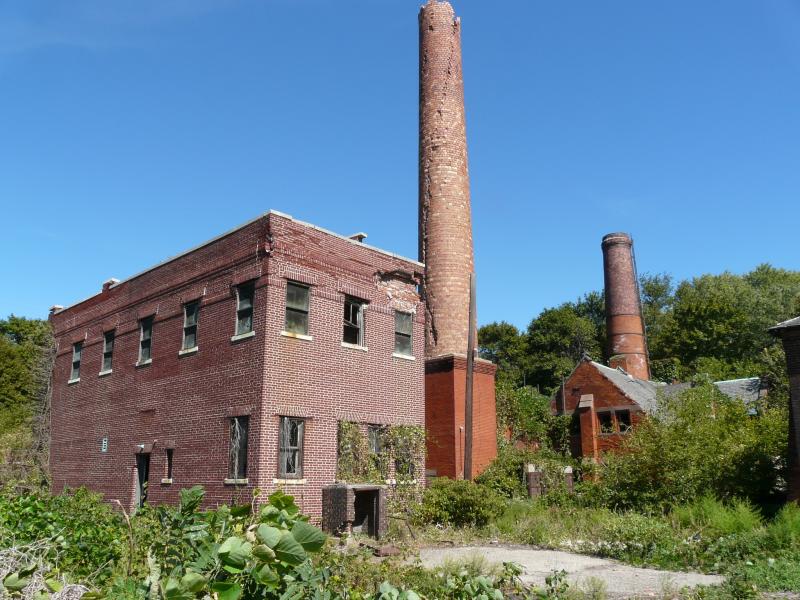
Photo courtesy of Michael Harrison © Image subject to Copyright
Just a short canoe or kayak trip down the New York City’s East River, about halfway between the Bronx and Rikers Island sits North and South Brother Islands. Today, the islands are a bird sanctuary, but the facilities on the property used to house a smallpox hospital and quarantine centre known as Riverside Hospital. The hospital operated from 1885 until the late 1930s, when it’s most infamous patient – a woman named Typhoid Mary— died.
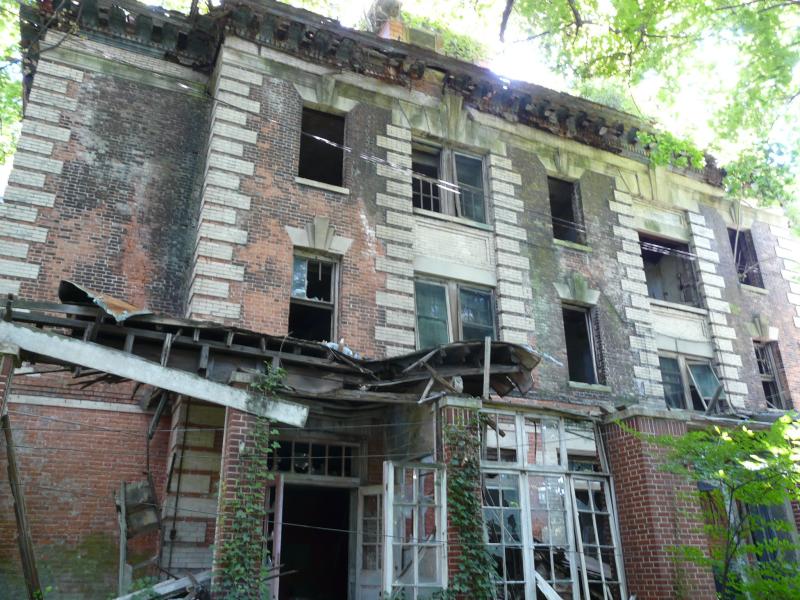
Photo courtesy of Michael Harrison © Image subject to Copyright
As nature grew to reclaim the islands, evidence of its human history can still be seen. There are plenty of trees and signs where it looks like guards on break at Rikers Island came for target practice. Old style architecture sits mostly untouched, except for the occasional tree root poking up through the tile. North Brother Island is one of those rare sites that’s remained untouched by vandals, left to decay naturally over time. As the scope of diseases in the early 1900s grew, the hospital acted as a centre for Tuberculosis patients and quarantines. Some of the artwork of these patients can be seen, hanging in the halls of the wards. Adventurers to the islands have posted accounts of seeing incredible collections of books, none dating past 1960, scattered about and having been repurposed as beehives. If you’re in the locale and looking for an exciting afternoon, Brother Islands won’t disappoint.
Spreepark – Berlin, Germany

Photo courtesy of Gregoire Cachemaille © Image subject to Copyright
Equally fascinating and creepy are abandoned amusement parks, and Germany’s Spreepark is no exception. The park has stood abandoned since 2002, falling quickly into disrepair. All of the rides still stand, the famous Ferris wheel and all. If you walk to the wheel, you’ll immediately see that the pier stretching over the water is almost entirely submerged. There are still swan boats lined up, waiting for their next charges to carry across through river – the river itself covered with a thick layer of neon lime algae. An entrance to one of the roller coasters stands ready, the mouth of a colourful cat gaping open ready to consume its next unsuspecting car that will never come.
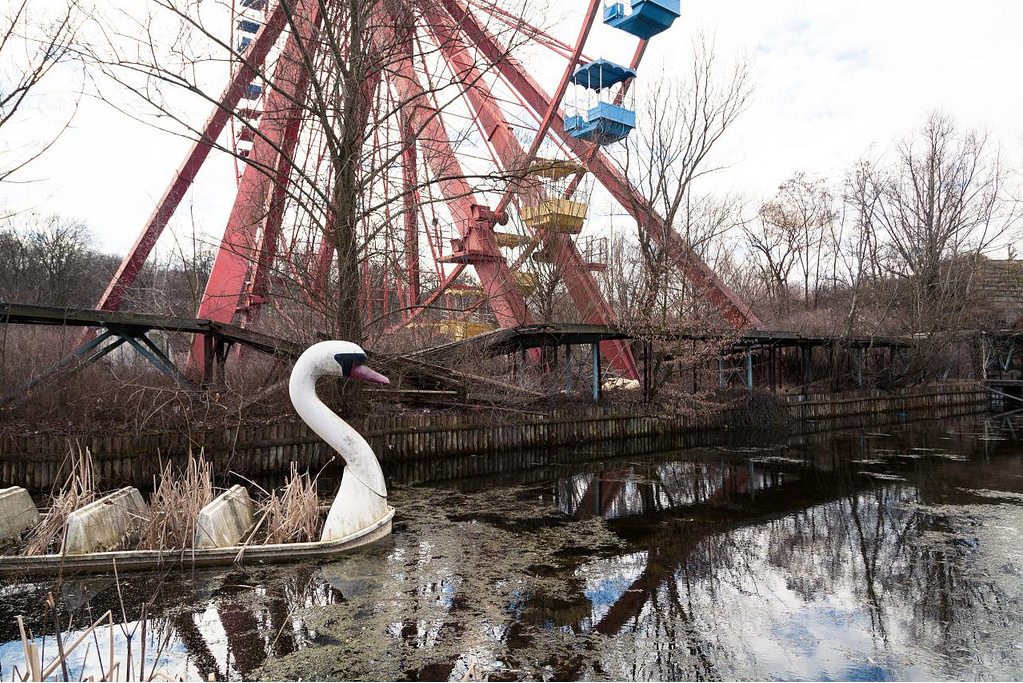
Photo courtesy of Gregoire Cachemaille © Image subject to Copyright
Many abandoned amusement parks aren’t as intact as Spreepark, and we imagine it’s due to the fact that the park has only been subject to decay for roughly thirteen years or so. Most of the foliage that’s overtaking the abandoned amusement park looks to be poisonous in nature, which is just as well since playing at an abandoned amusement park is never advised. Wandering through and observing an abandoned amusement park, on the other hand, is an entirely different story.
Loudoun Castle – Ayrshire, Scotland
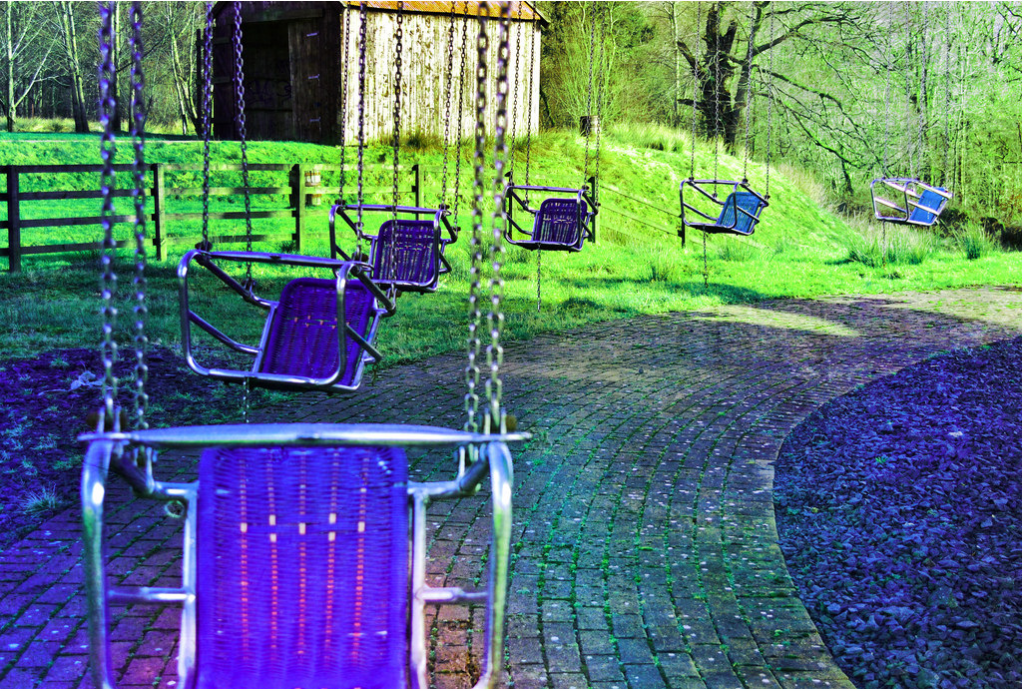
Photo courtesy of Michelle O’Connell © Image subject to Copyright
Next on our list is a well-hidden secret of Scotland, Loudoun Castle. An enchantingly decrepit amusement and leisure park, Loudoun’s most memorable feature is its gigantic swing ride. Loudoun Castle was a theme park that ran for a brief stint between 1995 and 2010, situated atop the ruins of the 19th century Loudoun Castle in Ayrshire. Billed as “Scotland’s best family theme park,” Loudoun Castle boasted 11 total rides, 5 of which were roller coasters. Upon closing of the amusement park, many of the park’s rides were packed up and relocated to other amusement parks throughout the United Kingdom.
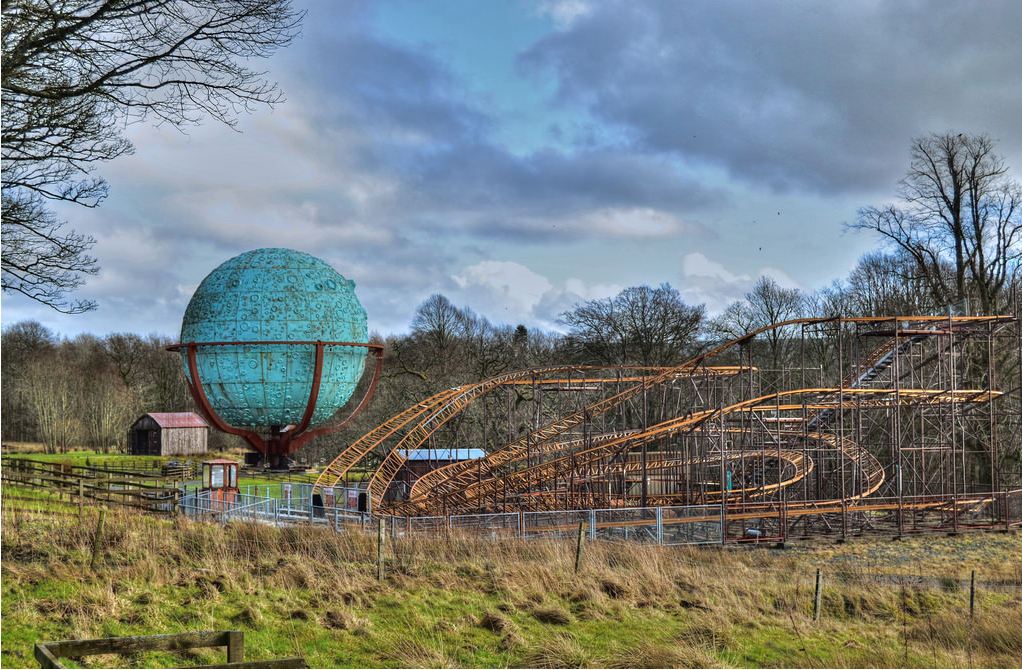
Photo courtesy of Michelle O’Connell © Image subject to Copyright
Still standing are the log ride and a couple of the rollercoasters, which look rather lonely in our opinion in the extensive meadows. While you can get inside some of the structures, they’ve been cleared out. There aren’t any interesting bits and pieces to explore left behind. Still, if you’d like to venture and see what nature has to offer in this abandoned amusement park, you’d better hurry. While the future of the site is still unknown, developers have talked about taking the acreage and turning it into a five-star hotel and luxury centre complete with golf course and academy, indoor sports facilities, and a subtropical water park.
Macassar Beach Pavilion – Cape Town, South Africa
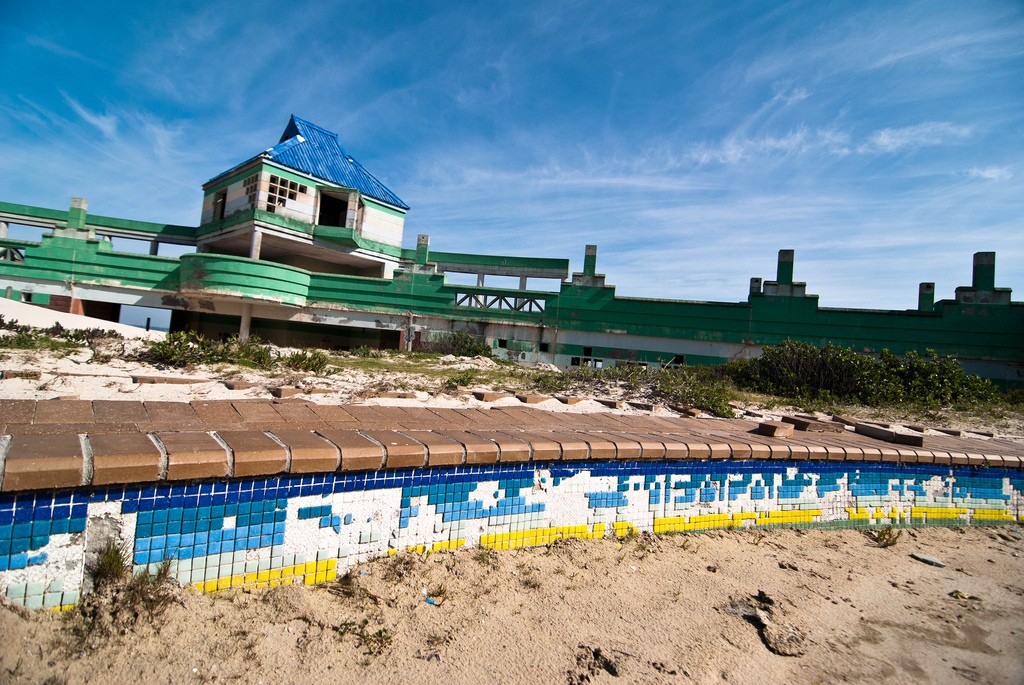
Photo courtesy of Adrian Bischoff (CC)
About a thirty-minute drive from Cape Town in the Western Cape is the Macassar Dune Reserve. Nestled among the dunes is what’s left of the Macassar Beach Pavilion. It used to be a bustling vacation centre for Cape Towners when it was built back in 1991 but has since been abandoned. Nobody knows when the beach resort went out of business and was left to fend for itself. Its water slides, wading pools and gazebos are being reclaimed by sand dunes. In fact, if you walk into some of the rooms you’ll find piles of sand to the ceiling. All that’s left of the once proud Beach Pavilion is now sticking up from the dunes, chipped and faded.
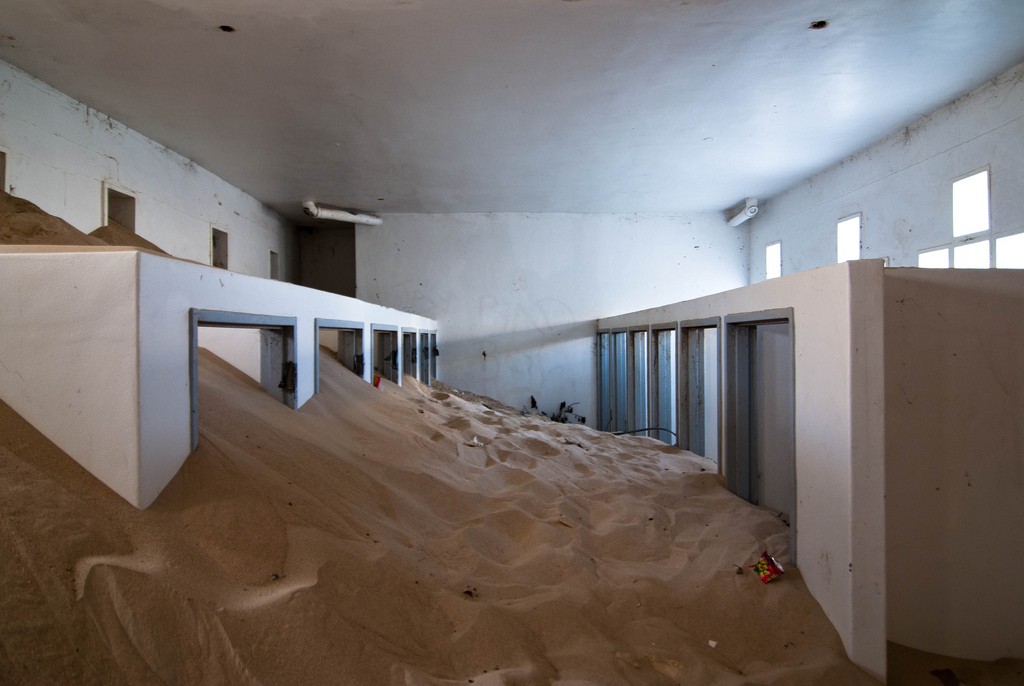
Photo courtesy of Adrian Bischoff (CC)
No one seems to mind, however. The Macassar Beach Pavilion is still familiar with one sect – photographers. We can’t blame passers-by for becoming entranced with the native sand dunes working hard to digest plastic water slides. It’s easy to lose perspective when looking at the abandonment of the Macassar Beach Pavilion; dune grass and other shrubbery has grown so tall that what seems to be a little is really meters in height. Paint has faded on the buildings, but the salt-water air hasn’t quite stripped its vibrancy. The entire area looks like it was meant to be part of an early-Stephen King short story.
Nara Dreamland Theme Park – Japan
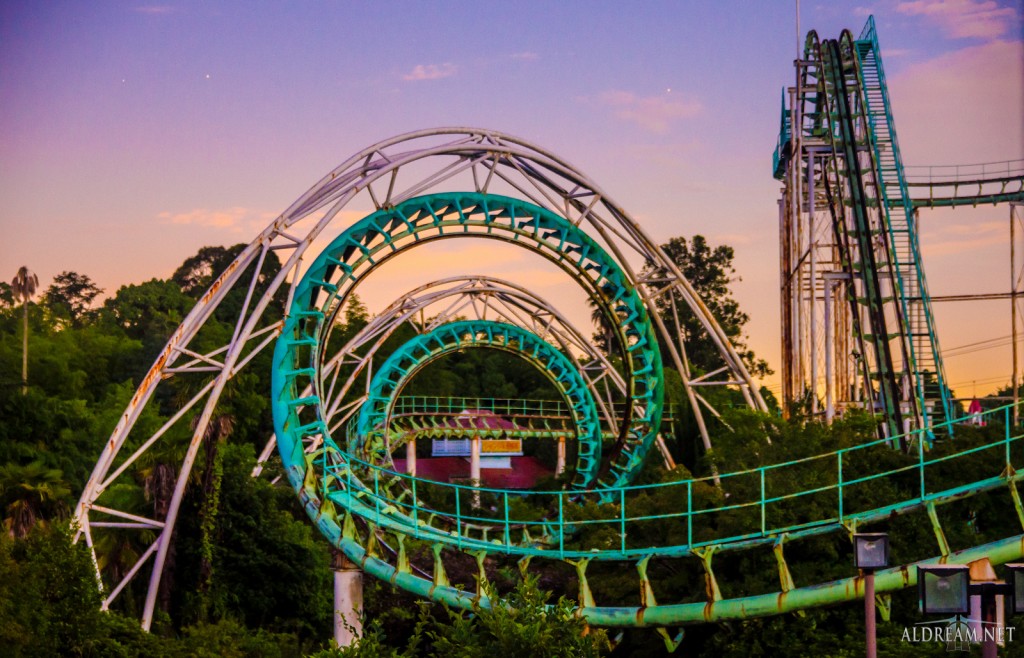
Photo courtesy of Benjamin (Bill) Planche © Image subject to Copyright
Abandoned for just over a decade, its sweets still sitting in the vending machines but no longer safe to eat is Nara Dreamland Theme Park. The park was built in 1961 as Japan’s answer to California Disneyland but closed in 2006 due to lack of interest and low ticket sales. The park fell into a state of disrepair, but not in the traditional sense. The mascots, machines, and rides are all still there and have an eerie dated feeling despite having been abandoned for just one decade. Many of the main attractions like the wicked witch from Sleeping Beauty, robot heads and carousel horses still sit ready and waiting.
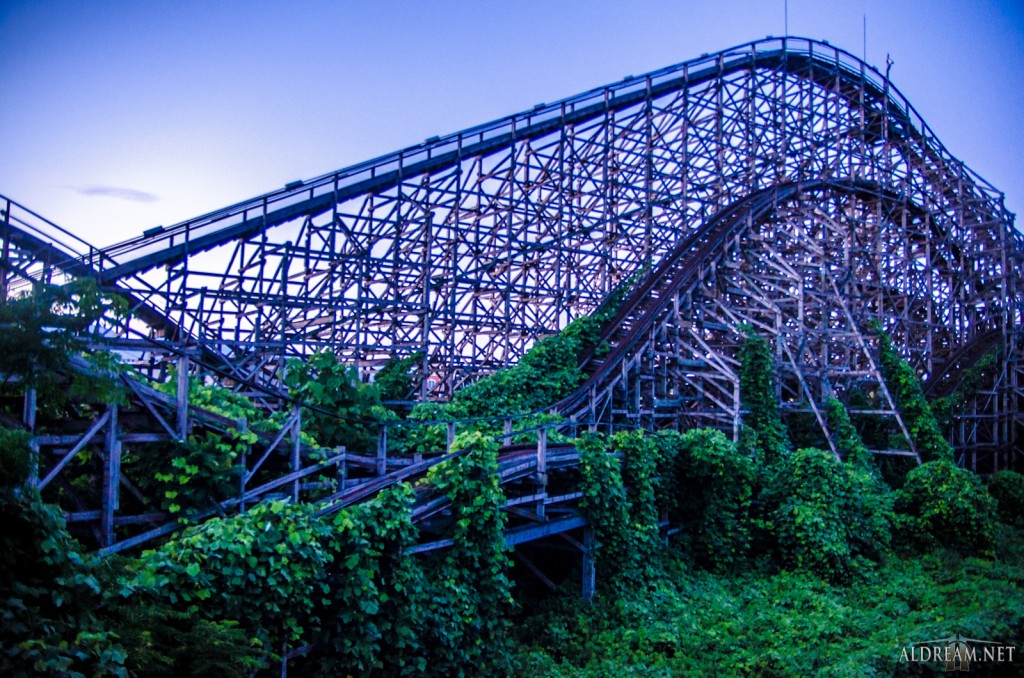
Photo courtesy of Benjamin (Bill) Planche © Image subject to Copyright
Perhaps the creepiest image is that of a spiralling rollercoaster silhouetted against the Japanese sunset, a field of tall, thick weeds manning the forefront. The Vikings dangling from up above one of the attractions look like they knew their heyday ended years ago but just haven’t gotten around to leaving. Aside from the cracked pavement and overgrown weeds the Dreamland’s main drag looks like a Disney parade could come rumbling around the corner at any minute. While the rides and giant fiberglass creatures may look safe enough to curious individuals, many of the support beams that hold up the park’s wooden roller coasters have rotted and give way easily. After all, the park is more than half a century old.
La Petite Ceinture – Paris, France
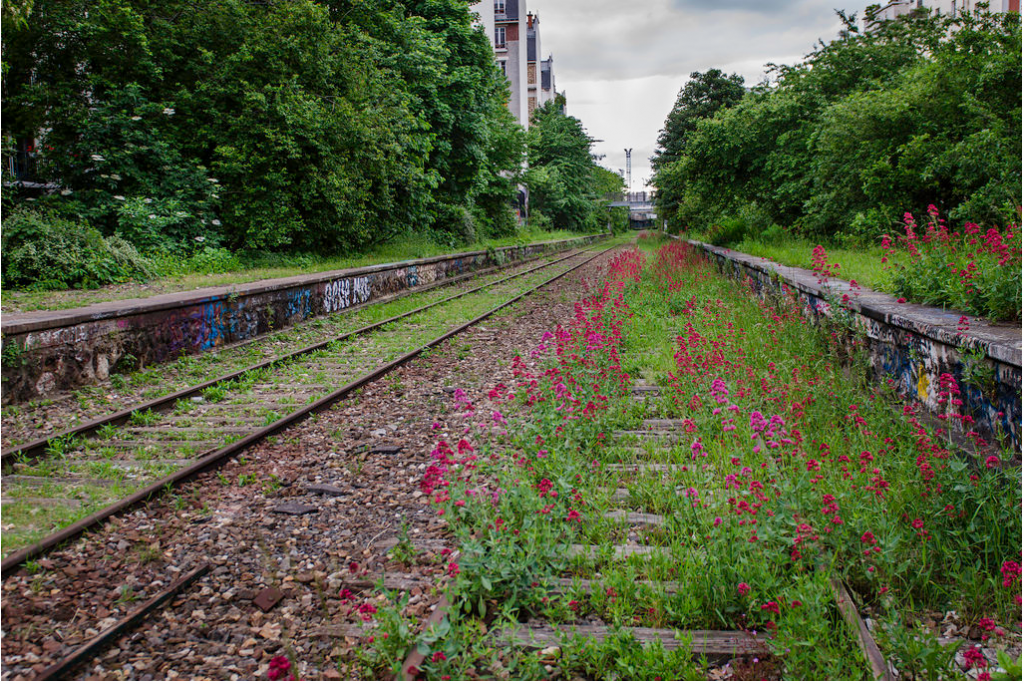
Photo courtesy of Alexander J.E. Bradley © Image subject to Copyright
What gave busy Parisians a way around the capitol city more than 150 years ago now sits abandoned and overgrown with native vegetation, a stunning testament to what time and nature can accomplish. The name loosely translates as “Little Belt,” and since becoming abandoned and sealed off in 1934 La Petite Ceinture has served as a bit of an escape for determined city dwellers. Of the original 29 stations, there are 17 remaining along the railway, and since it’s situated directly above the Parisian catacombs, it isn’t unusual to see urban explorers emerge from one of the entrances that dot the line.
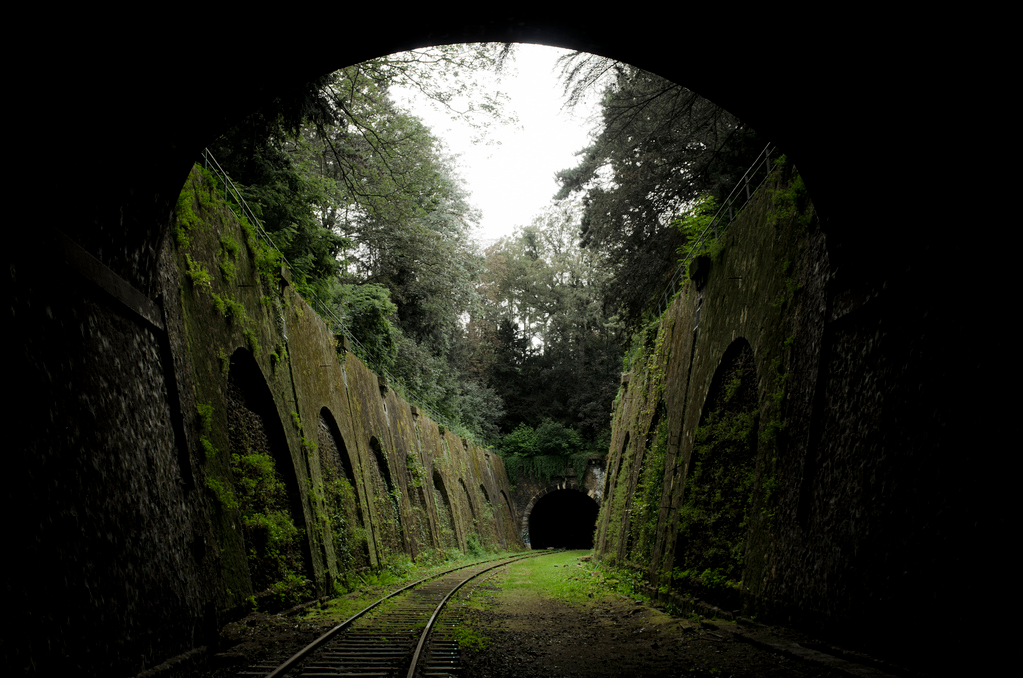
Photo courtesy of Alexander J.E. Bradley © Image subject to Copyright
Though the tracks and railway have been closed for more than 80 years, it isn’t too hard to find a way to the secret gardens that nature has reclaimed. The 17-mile stretch of railway is a treasured part of French rail system history. All kinds of graffiti art thrive in the railway, both of the typical and more creative varieties. The railway tunnels have curtains of vegetation hanging down, and a peaceful quiet emanates throughout the Little Belt with the din of Paris in the background. Nature is thriving so much in La Petite Ceinture, in fact, that surrounding Parisian homes and courtyards have become overgrown in some areas. La Petite Ceinture is one of Paris’ last green spaces and recently has become a hotbed of political debate.
Kayakoy (Karmylassos in Greek) – Turkey

Photo courtesy of R Garbett © Image subject to Copyright
Kayakoy takes our list of places that nature is reclaiming by storm. It’s the first ghost town we’ve seen but don’t let it’s looks fool you. Though this Turkish town was built in the 1700s, it wasn’t deserted until the 1920s for curious reasons. Basically, because of all the bloodshed related to the collapse of the Ottoman Empire, World War I and continued conflicts, both the Greek and Turkish governments signed what was essentially a “population swap”. Since the exodus wasn’t a bloody one, nature was left to take over its land.
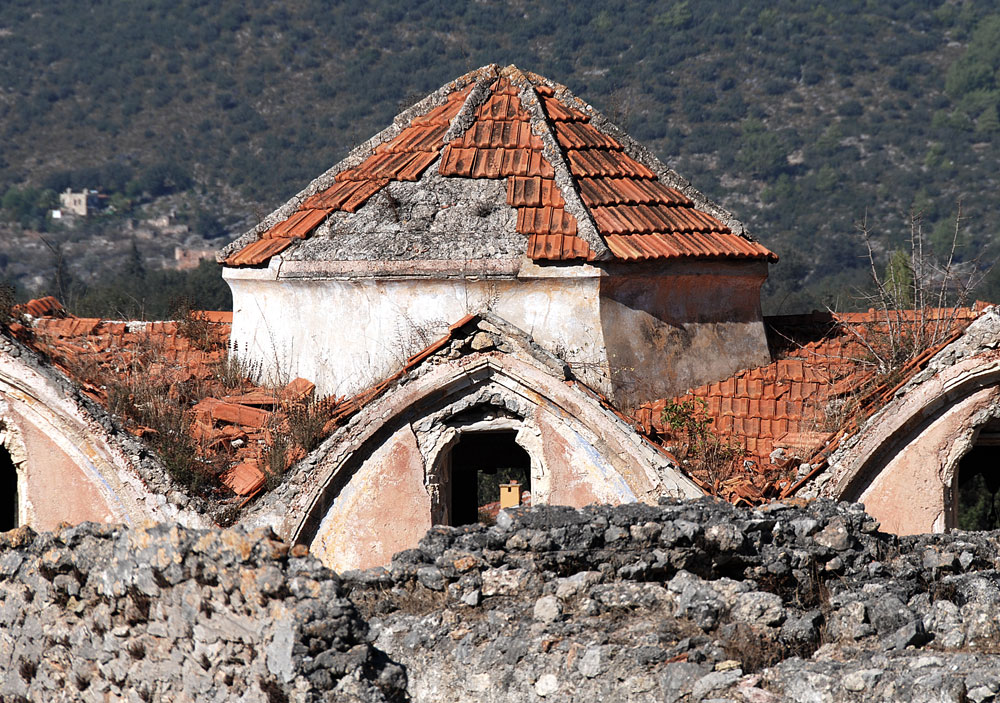
Photo courtesy of R Garbett © Image subject to Copyright
The Turks didn’t want to leave Greece, but the Greeks were okay with leaving Turkey, so the end result was 350 homes, two Greek Orthodox churches, fountains, cisterns, and other ruins in Kayakoy. The remains of the ghost town were largely destroyed by an earthquake in 1957 and harsh climate, but flowering climbers and vines are plentiful. These days, guides give walking tours throughout the ghost town of Kayakoy, and it makes for a beautiful, serene expedition if you so happen to be traveling through southwestern Turkey.
“Pompeii of the Caribbean” – Plymouth, Montserrat, West Indies
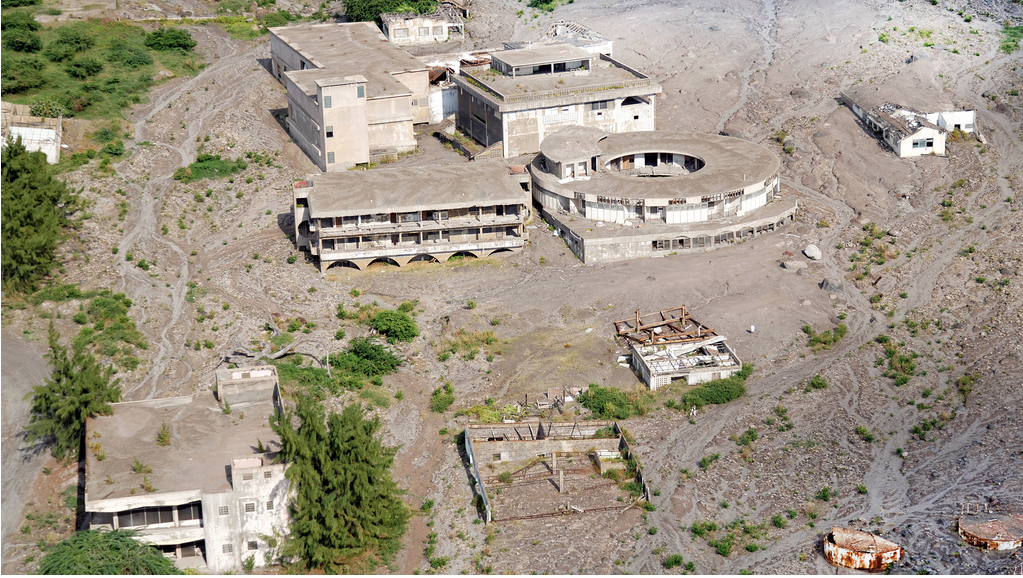
Photo courtesy of AV8PIX © Image subject to Copyright
The capital city of the island of Montserrat, Plymouth is another location on our list that nature took back forcefully. It all began in 1995 when, after a series of volcanic eruptions, prompting people to abandon the city. Dwellings, government structures and other buildings were covered in ash. In August of that same year, any remaining residents were officially evacuated. Residents were allowed back a few months later, and everything seemed fine. Then, in June 1997 there was a massive eruption that killed 19 people and caused a series of lava flows that buried 80% of the city under nearly 5 feet of hot lava.

Photo courtesy of AV8PIX © Image subject to Copyright
Much of the remaining area is still covered in ash remnants. However, volcanic ash is rich in nutrients, and many tropical plants in the now-empty homes are thriving. The disaster occurred relatively recently, so one can only imagine the diverse life that will continue to grow. Birds of Paradise and other exotic flowers have indeed taken their homes back. While it is possible to explore the former capital town of Plymouth, signs posted recommend against it.
Sanzhi Pod City – New Taipei City, Taiwan
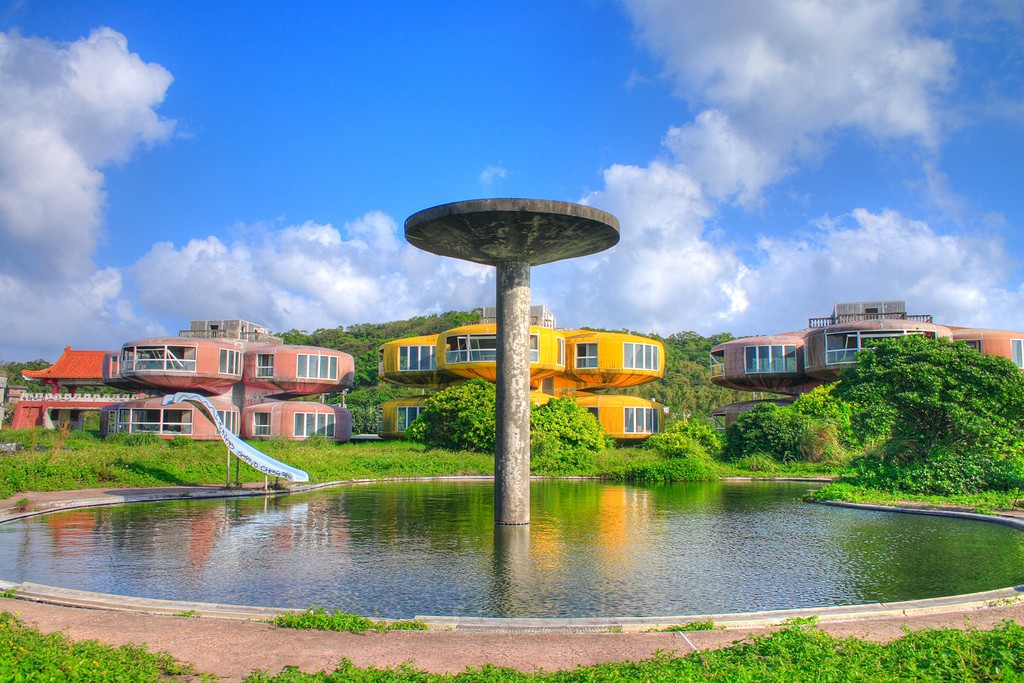
Photo courtesy of Chao-Wei Juan(CC)
These curious-looking abodes and the story that goes along with them sounds like it was meant more for the big screen, but we promise it’s real. These candy-coloured pod homes were built in 1978, and they were intended as vacation homes for U.S. military officers as well as wealthy Taiwanese businesspeople. According to local lore, the flats were built on top of a Dutch burial ground, and during construction there were several bizarre deaths, suicides, and car accidents – related perhaps? Regardless, the strange and ballsy design was attractive at the time; just nobody could (reportedly) afford the futuristic resort homes.

Photo courtesy of Chao-Wei Juan(CC)
Despite breaking ground on construction a mere two years earlier, the buildings were abandoned in 1980 and remained there until 2010. All of the UFO houses have now been demolished and the site was in the process of being converted to a commercial seaside resort and waterpark. Haunted or not, the colours, retro-futuristic landscape, and haunting appearance made the Sanzhi Pod City quite a sight to behold. The stacked buildings are also called the “ruins of the future,” and “UFO houses.”
Hashima Island “Battleship Island” – Nagasaki Coast, Japan
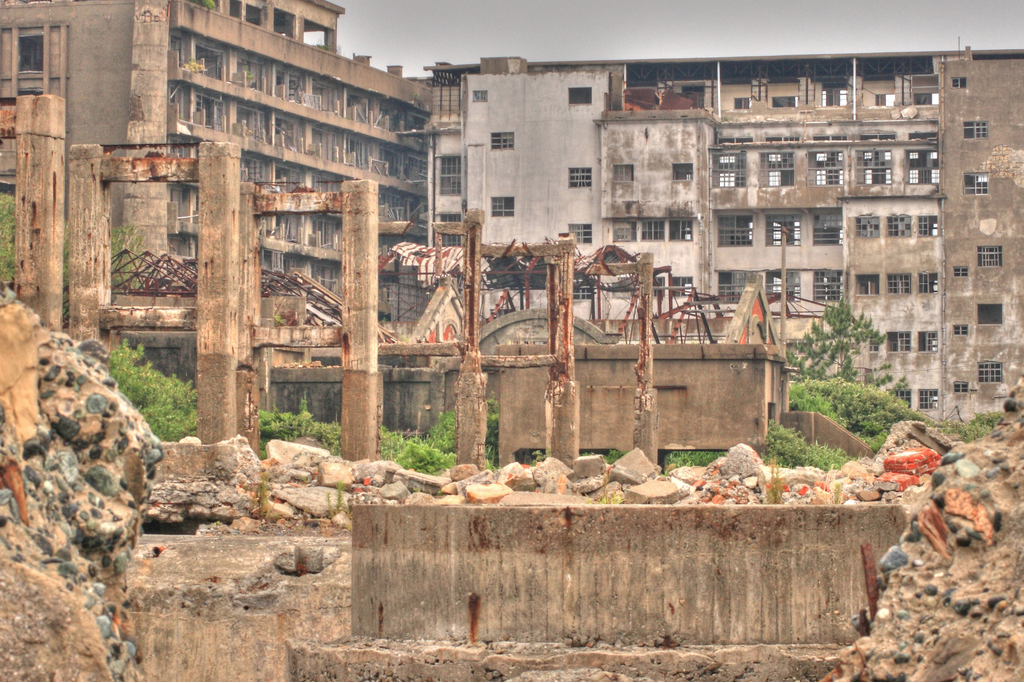
Photo courtesy of Miki Nagata © Image subject to Copyright
This small island off the coast of Nagasaki, Japan was home to coal miners, who, in fact, had lived and mined on the island since the early 1800s. At its peak population in the 1950s, there were about 5,300 inhabitants on the island. Inhabitants left the island in 1974 with the closure of the mine. When everyone packed up and left, the island gained a reputation for being haunted. The island itself had a notorious history, having housed Chinese and Korean prisoners who were forced to work there during World War II.

Photo courtesy of Miki Nagata © Image subject to Copyright
Hashima Island is extremely popular among ruin enthusiasts for its whole apartment complexes from the Taisho period, though it looks more like a post-apocalyptic war zone these days. Nagasaki City has tried to construct a pier for tourists to land and see the famed island, yet the island itself is situated in an extremely treacherous section of water. Only fifty percent of boats that try to land are successful, during optimal weather that number rises to eighty percent. The Japanese apartment complexes are completely furnished, with television sets and everything else necessary. However, since the island has been sitting uninhabited for more than fifty years, many of the buildings are collapsing. These collapses have sparked new interests on the Japanese island.
Hafodunos Hall – Wales
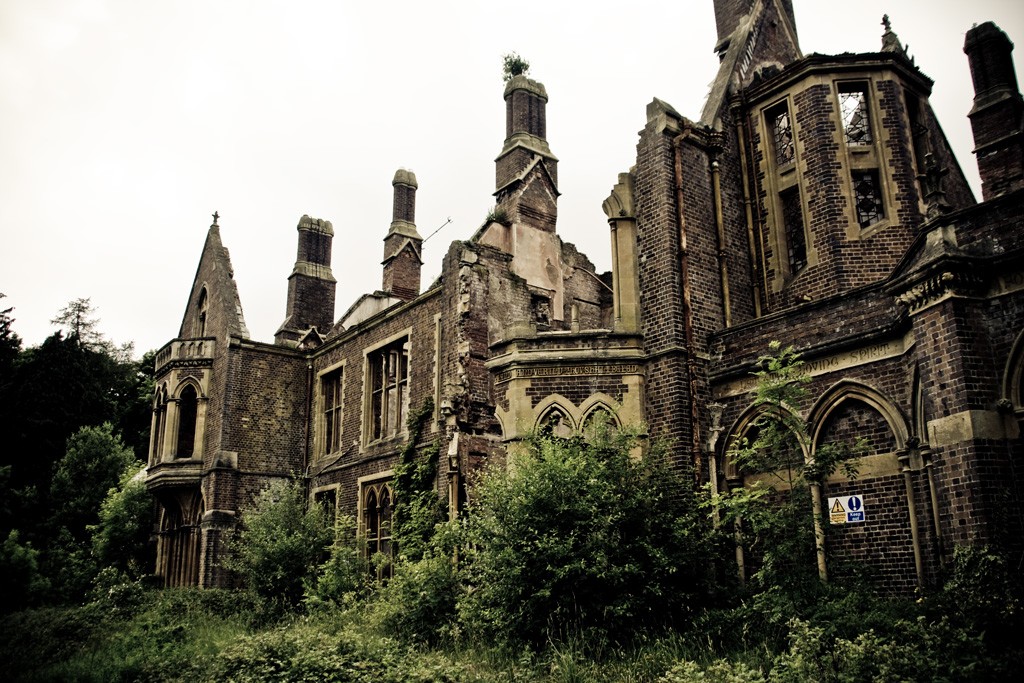
Photo courtesy of Carl Jones(CC)
Hafodunos Hall is a lavish, extravagant Gothic Revival-style home that was built in 1861 to replace a house that had stood there since the 1600s. It’s fantastic rooms and detailed architecture have withstood time. The marble sculptures that used to grace the halls now rest at the Walker Art Gallery in Liverpool. The home’s unusual arches and scrolled columns are covered in ivy and greenery, but the home hasn’t lost its regal air. An old stone clock still stands in what used to be the Hafodunos clock tower structure; its hands have stopped moving by now.
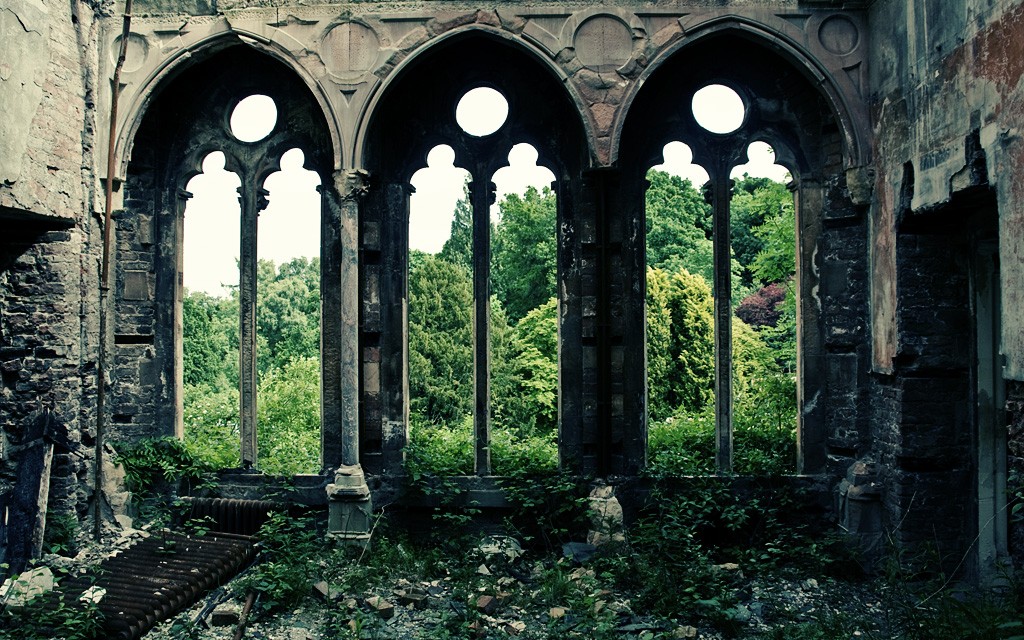
Photo courtesy of Carl Jones(CC)
The home is privately owned and was damaged back in 2004. Young kids have broken in and left their fair share of graffiti on the walls, yet something about Hafodunos still seems untouched. Many of the rooms look out over the expansive scenery, and the entire place has a peaceful feeling to it. While this location may seem like a royal building, our next entry is truly a castle.
Bannerman Island Castle – Pollopel Island, New York
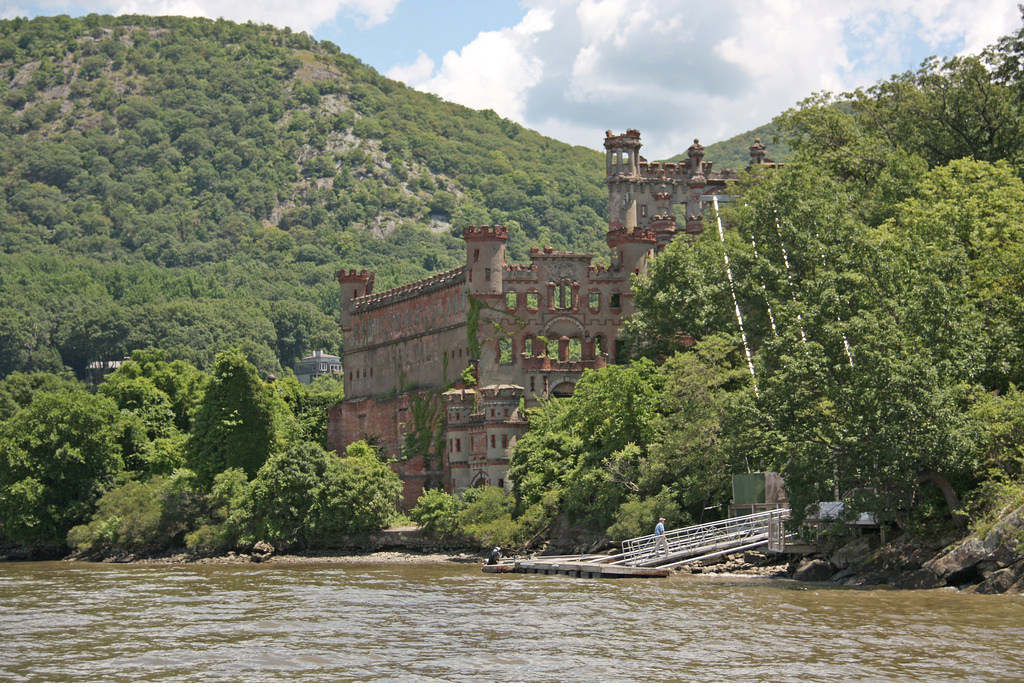
Photo courtesy of Jeff Terranova © Image subject to Copyright
This next find takes us all the way back to New York, on the eastern shore of the Hudson River about fifty miles north of New York City to be exact. The place is Bannerman’s Island Arsenal, and the building itself looks like it was plucked from some fairy tale. The Bannerman Castle was used to house military supplies and as an arsenal throughout most of its life and seemed quite impenetrable in its day. It was known as the Grandfather of the Army-Navy Store. Sadly, many features of Bannerman Castle have crumbled in storms as are reported locally. But the parts of Bannerman Castle that still stand are being reclaimed entirely by nature.

Photo courtesy of Jeff Terranova © Image subject to Copyright
The State of New York purchased and has maintained ownership over the island for more than thirty years, but before that local legends about hauntings would keep people away. The castle itself is in a precarious position; it isn’t stable enough to be opened to the public, yet there are plenty of considerations that need to be managed if it’s to stand another hundred-or-more-years.
The Deep Valley of the Mills – Sorrento, Naples, Italy
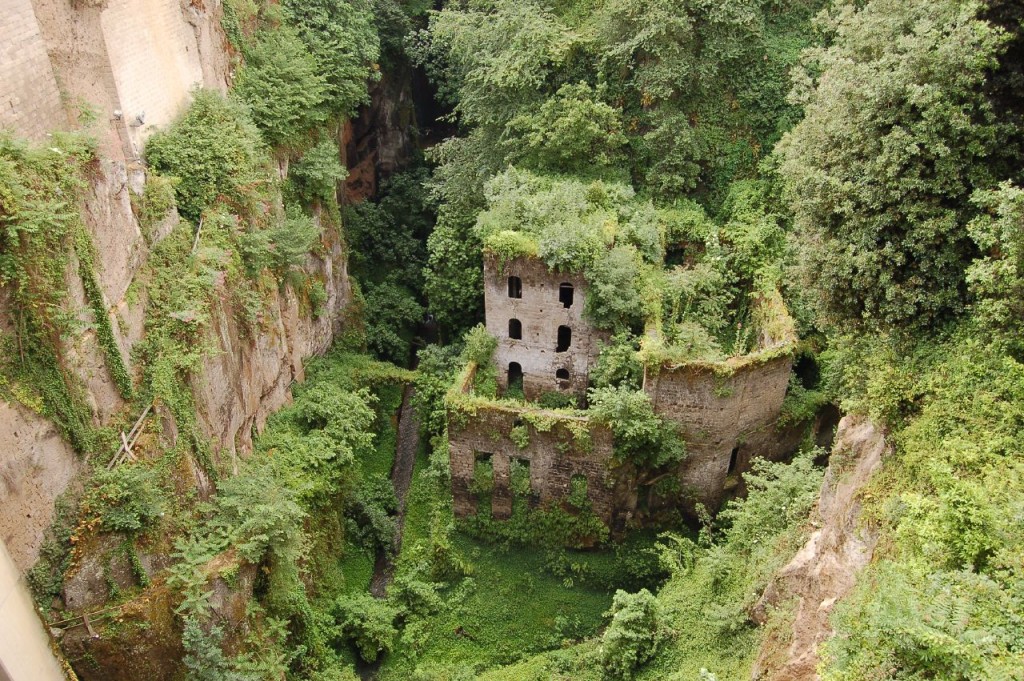
Photo courtesy of Dave © Image subject to Copyright
Next up is a place that was an industrial hub back a couple thousand years ago. The Deep Valley of the Mills is what it looks like when nature reclaims ancient grounds. The Valley of the Mills dates all the way back to 900 AD and was a grain mill. The mill was manned by women during the day who would sit and grind the grain, but the humidity and heat rose gradually over time, which led everyone to abandon the mill in 1866. The resulting buildings look like they are frozen in time; many stone faces are completely covered in moss or ivy. Generations worth of foliage grows on the roof of the mill and out of the windows.

Photo courtesy of Dave © Image subject to Copyright
The water in the valley dried up over time, and with the disappearance of humans came the reappearance of many forms of plant life. Some plants that turned up and thrived in the Valley of the Mills were even considered rare or almost entirely extinct like bushes of capers, certain carnivorous plants, and the Phyllitis vulgaris. Lush, greenery such as is found in the Valley of the Mills these days is worth the trip to see.
SS Ayrfield – Coast of Sydney, Australia
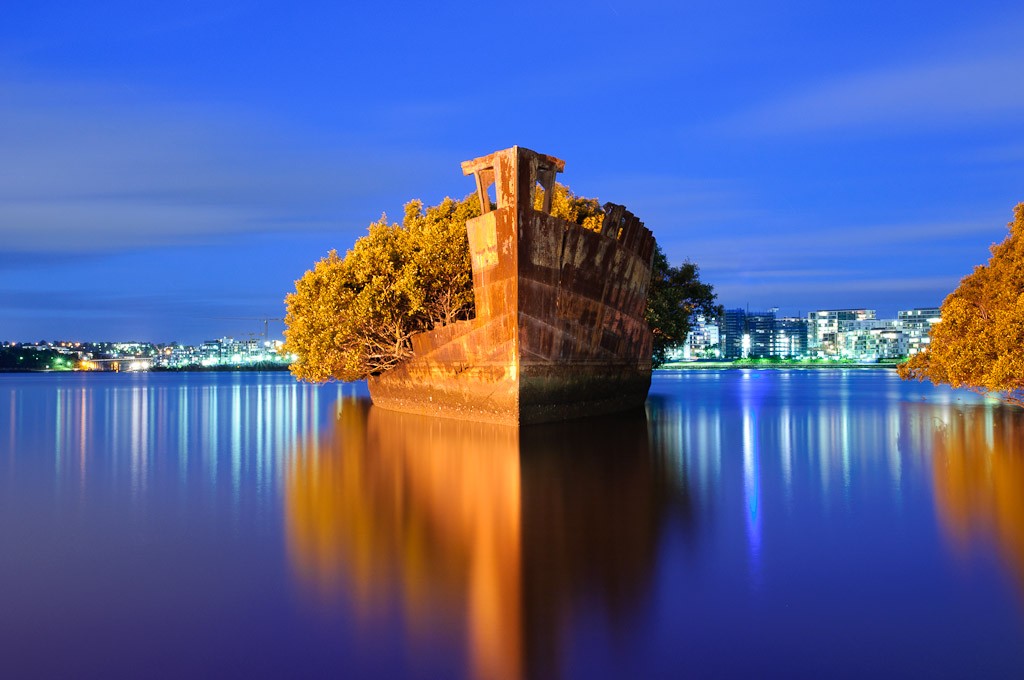
Photo courtesy of Rodney Campbell(CC)
The SS Ayrfield is one of the most beautiful and awe-inspiring testaments to what can be done with an old, out-dated war machine and a little bit of nature. You see, the SS Ayrfield is one of many decommissioned ships in Homebush Bay, yet there’s one stark characteristic that sets it apart: it’s a floating forest! Since being retired in 1972, the SS Ayrfield has found a new purpose in life, one as a mangrove forest. Its huge, rusting metallic hull is near bursting with trees and greenery, drawing spectators from far and wide.
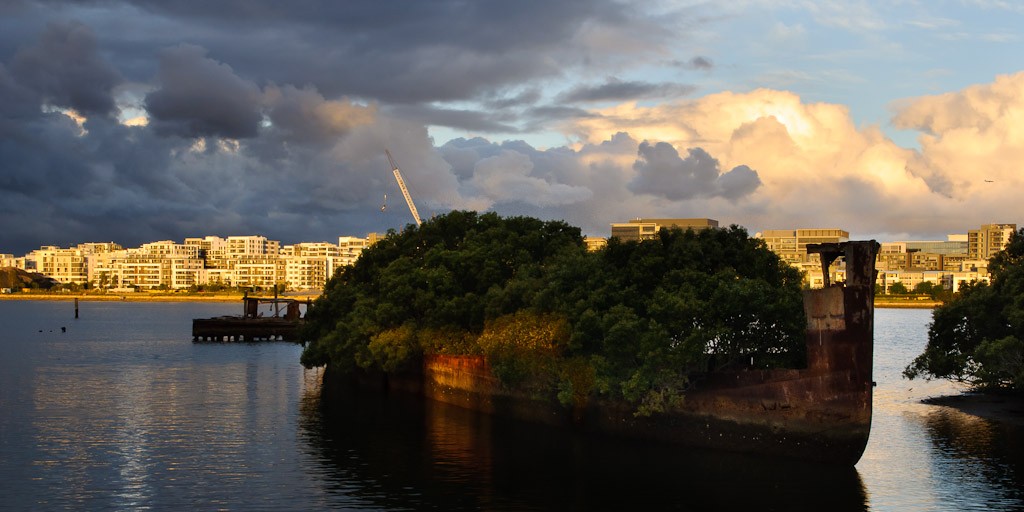
Photo courtesy of Rodney Campbell(CC)
Apparently, there are three to four other metal ships that float aimlessly in the Homebush Bay, but the Ayrfield is the only one to have sprung life. It looks quite striking in the sunset. We think that’s quite a lovely fate for a 102-year-old ship, especially when you consider the usual fate is to be taken apart. At the publishing of this article, there were no plans to let any of the other ships in the Bay turn into floating forests.
The Bike Tree & Cadillac Ranch– Vashon Island, Washington & Amarillo,

Photo courtesy of sea turtle (CC)
Watch out! This is a case of nature becoming the aggressor in the case of Washington’s Bike Tree. The bike was supposedly abandoned by a man named Don in 1954 when he left it leaned next to a fir tree only to see it consumed. Local vandals have since stolen almost all of the parts of the original bicycle, but that doesn’t stop its fame from spreading far and wide. It may take upwards of thirty years for a bike to be successfully eaten by a tree, in case you were wondering. After digging a bit, we found several of these bicycle-eating trees but can’t figure out just what made the bicycles so attractive. Along those lines is the famous Cadillac Ranch in Amarillo, Texas.
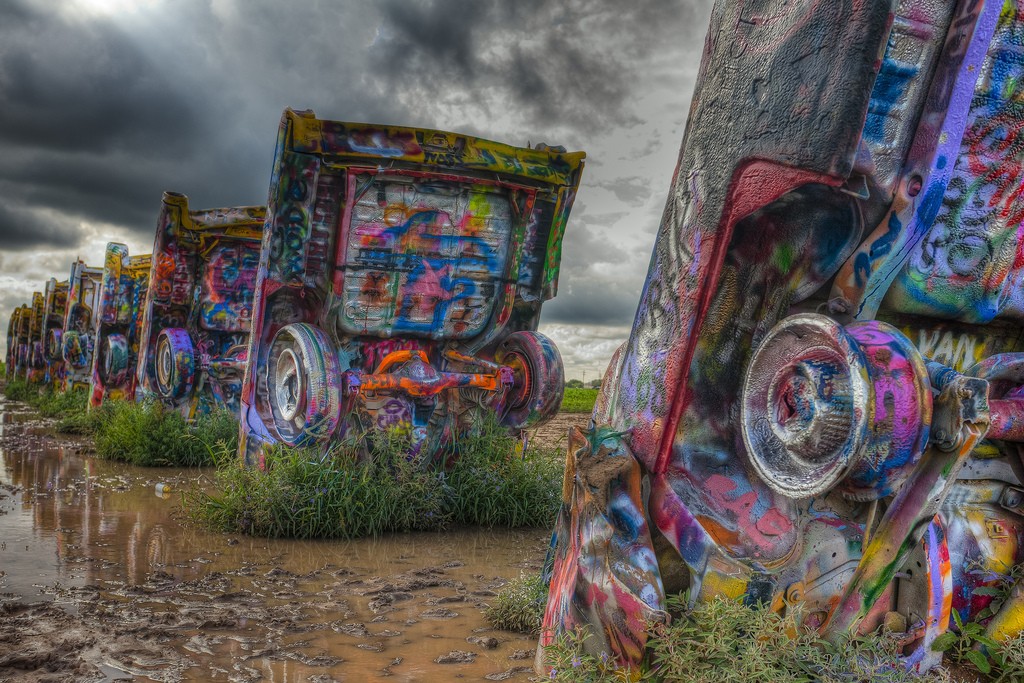
Photo courtesy of George Thomas (CC)
The Cadillac Ranch in Amarillo has been a popular roadside attraction since the early 1970s when a group of hippies from San Francisco buried their very first Cadillac in the sand. They called themselves the Ant Farm and have since encouraged the vandalism of their artworks. The Cadillac Ranch has become a must-stop on the pilgrimage across the Mother Road (Rt 66) Visitors make the trek to the Cadillac Farm with spray paint in one hand and cameras in the other, so make sure to take picture proof of your graffiti-art cause chances are, it’ll only be a few hours before someone creates their artwork on top of yours.
Abandoned War Machines
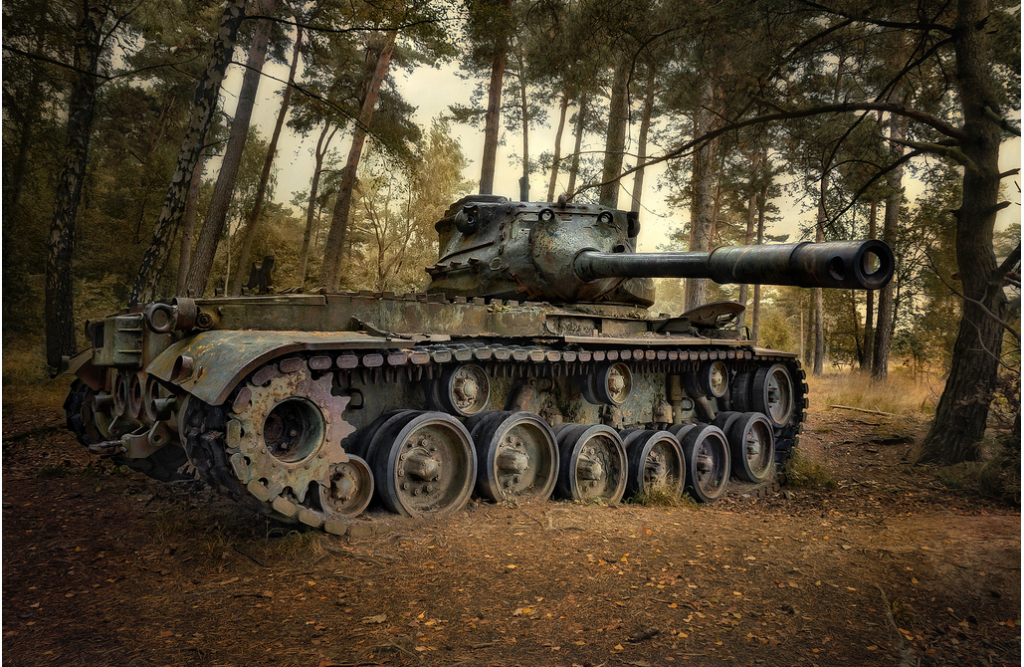
Photo courtesy of DARKstyle Pictures © Image subject to Copyright
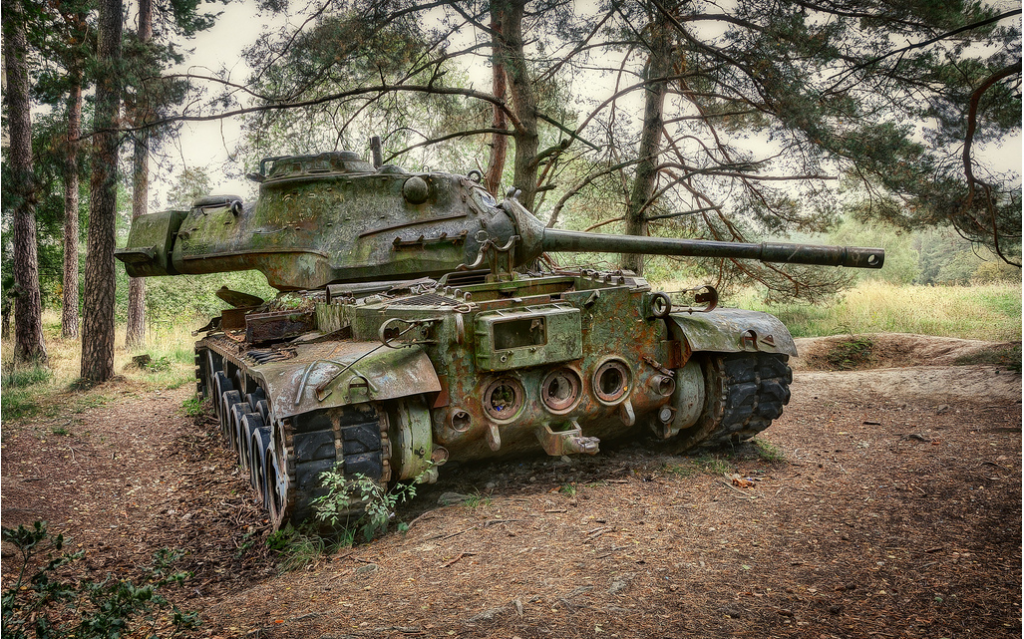
Photo courtesy of DARKstyle Pictures © Image subject to Copyright

Photo courtesy of DARKstyle Pictures © Image subject to Copyright

Photo courtesy of David Stanley(CC)
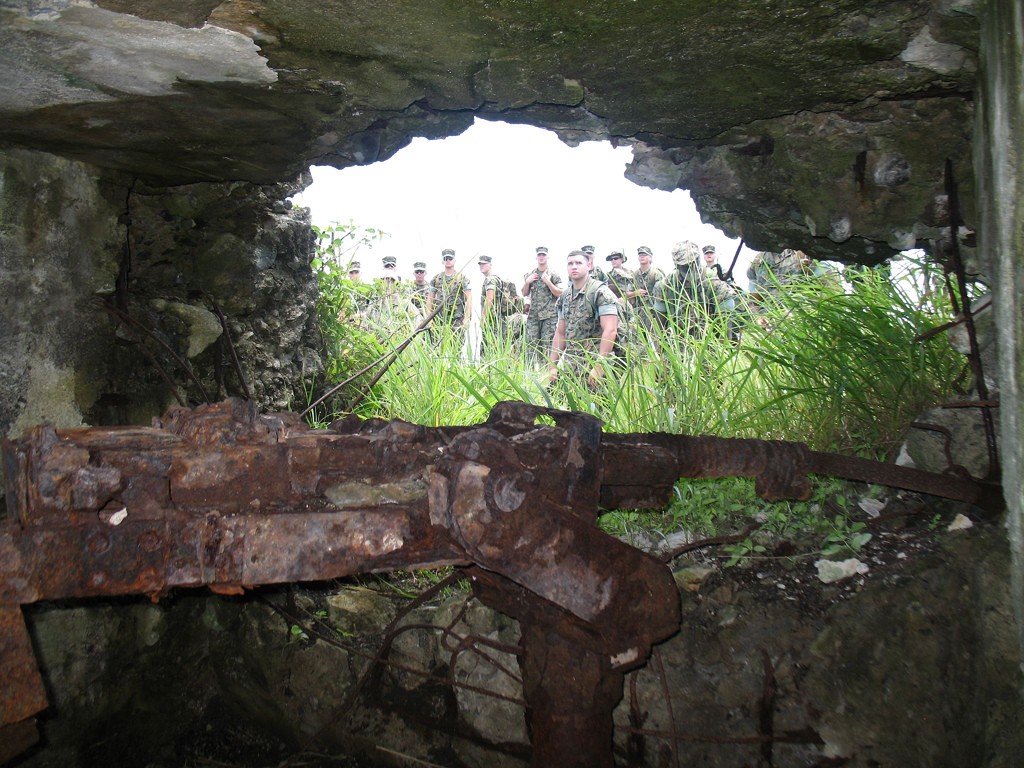
Photo courtesy of Kenneth Taylor Jr(CC)

Photo courtesy of Kenneth Taylor Jr(CC)
Forgotten Vehicles
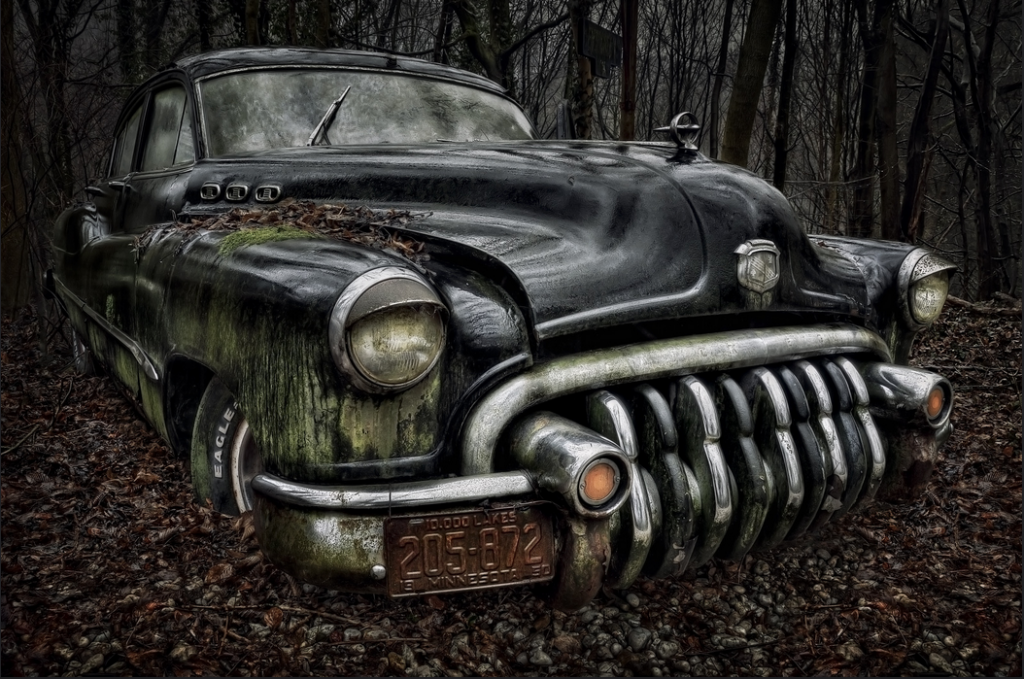
Photo courtesy of DARKstyle Pictures © Image subject to Copyright
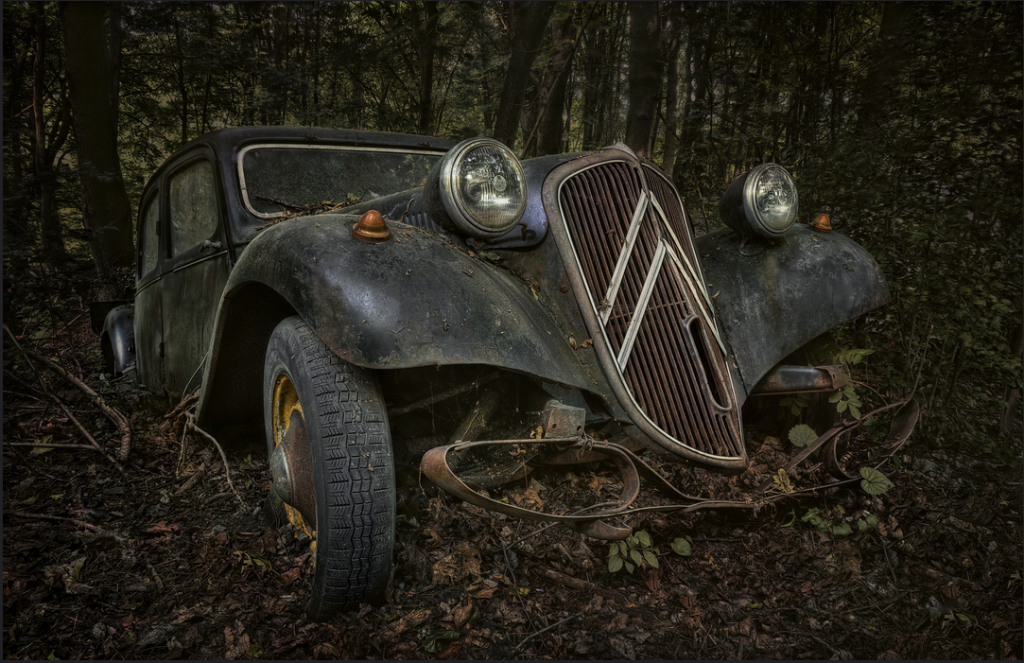
Photo courtesy of DARKstyle Pictures © Image subject to Copyright
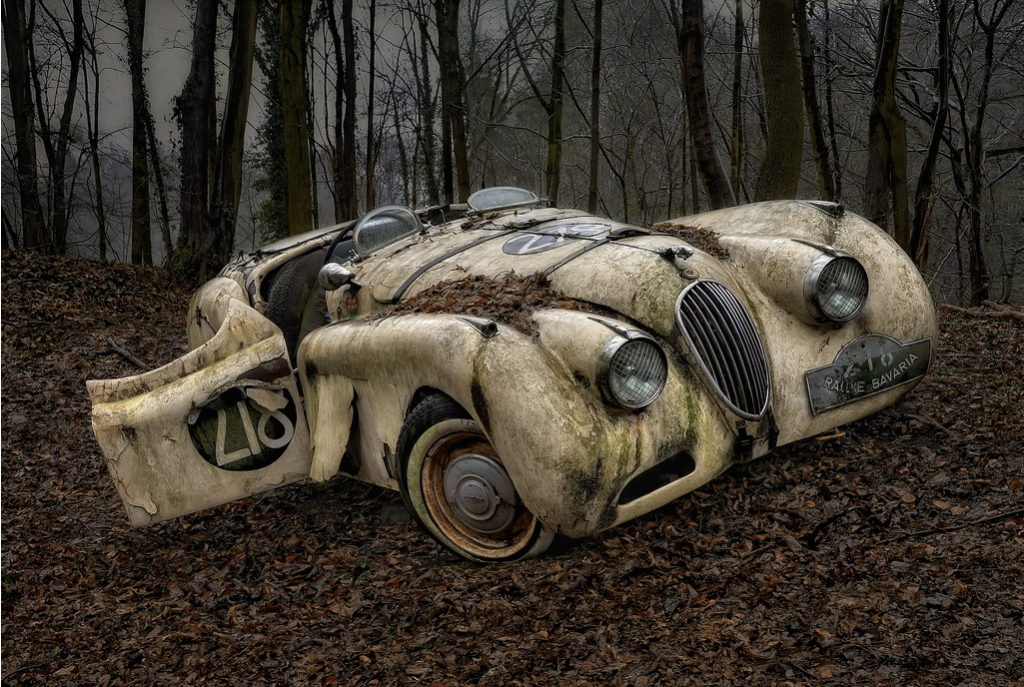
Photo courtesy of DARKstyle Pictures © Image subject to Copyright
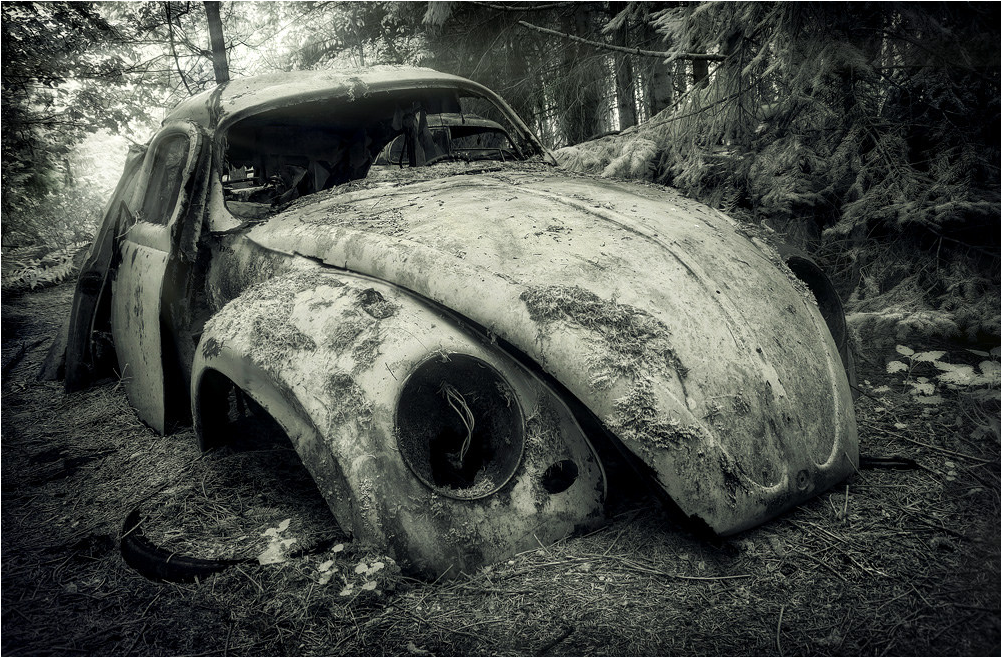
Photo courtesy of DARKstyle Pictures © Image subject to Copyright

Photo courtesy of David Train (CC)
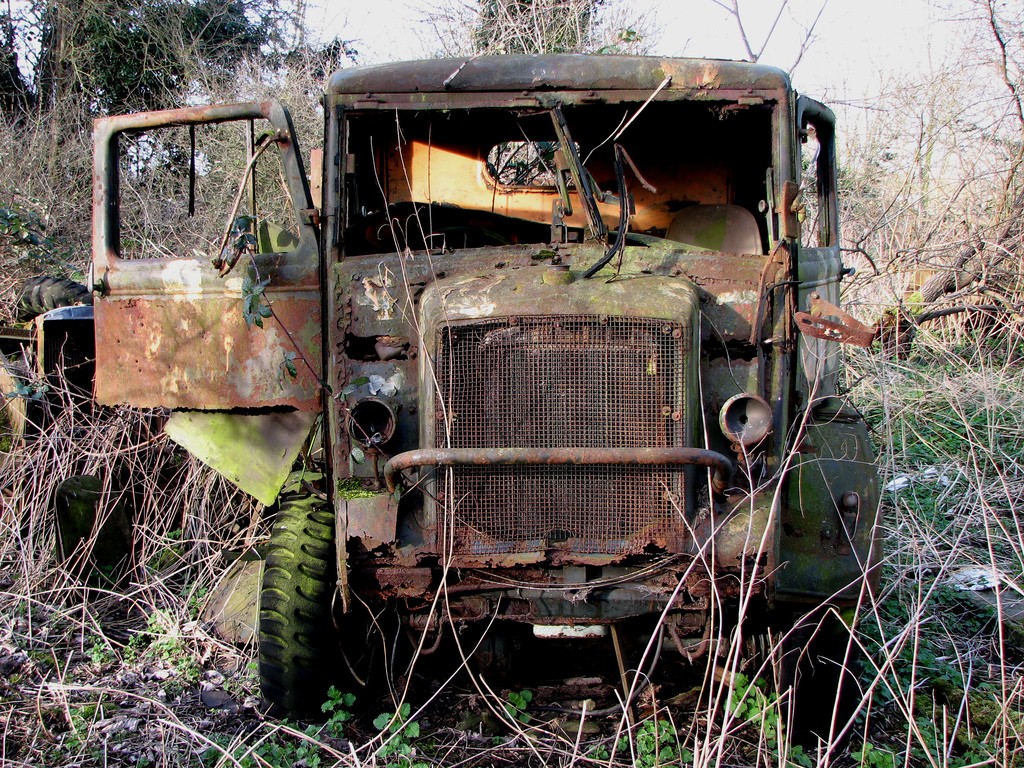
Photo courtesy of David Train (CC)
Check out DARKstyle Pictures for some really creepy and awesome images:
Thank you to all of the photographers, for permission to use their photos. And also a BIG thankyou to our writer, Kali Simone for putting together the fantastic writing on each of the locations!

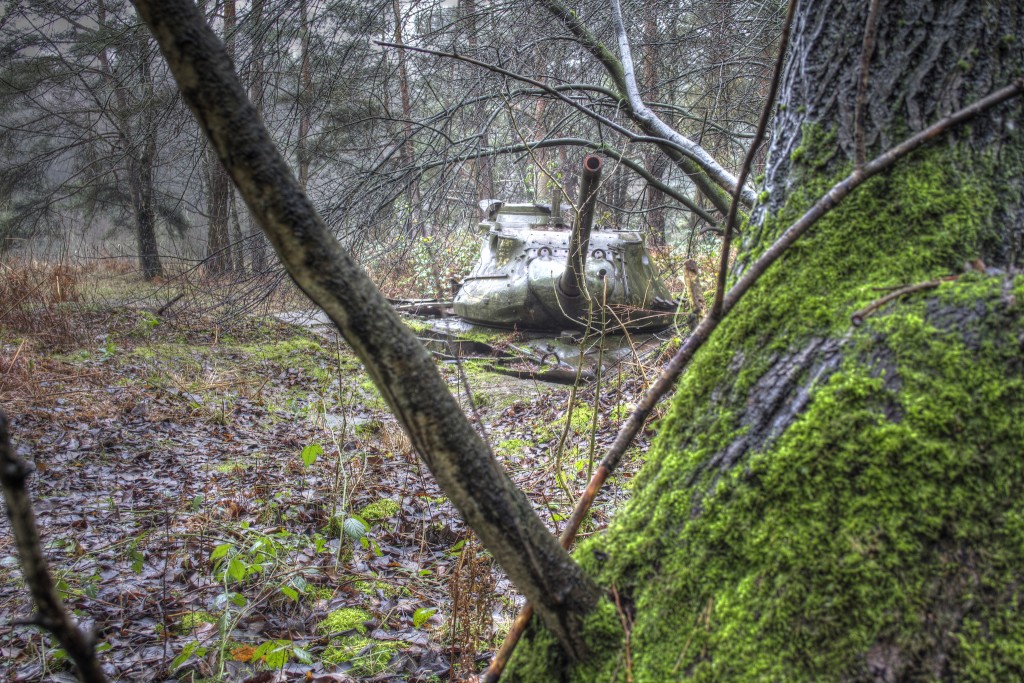
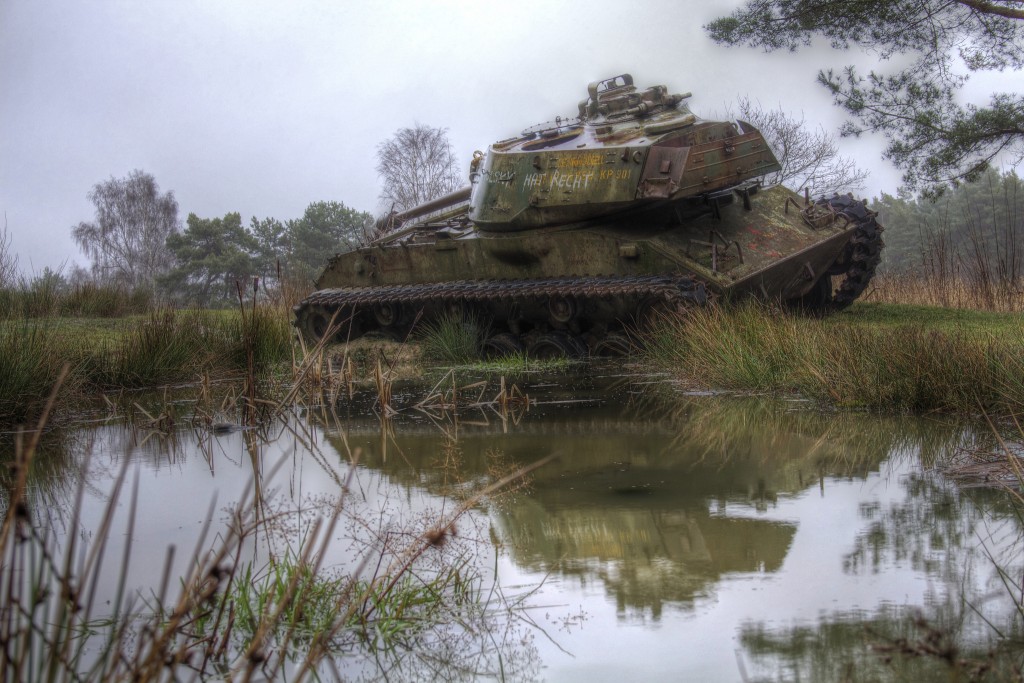

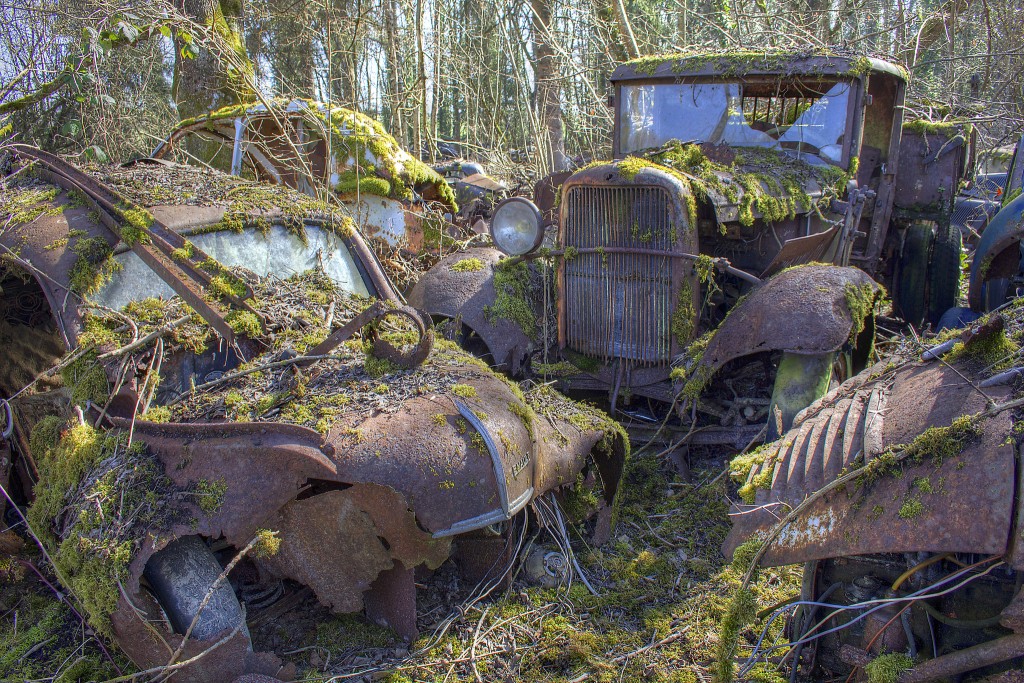


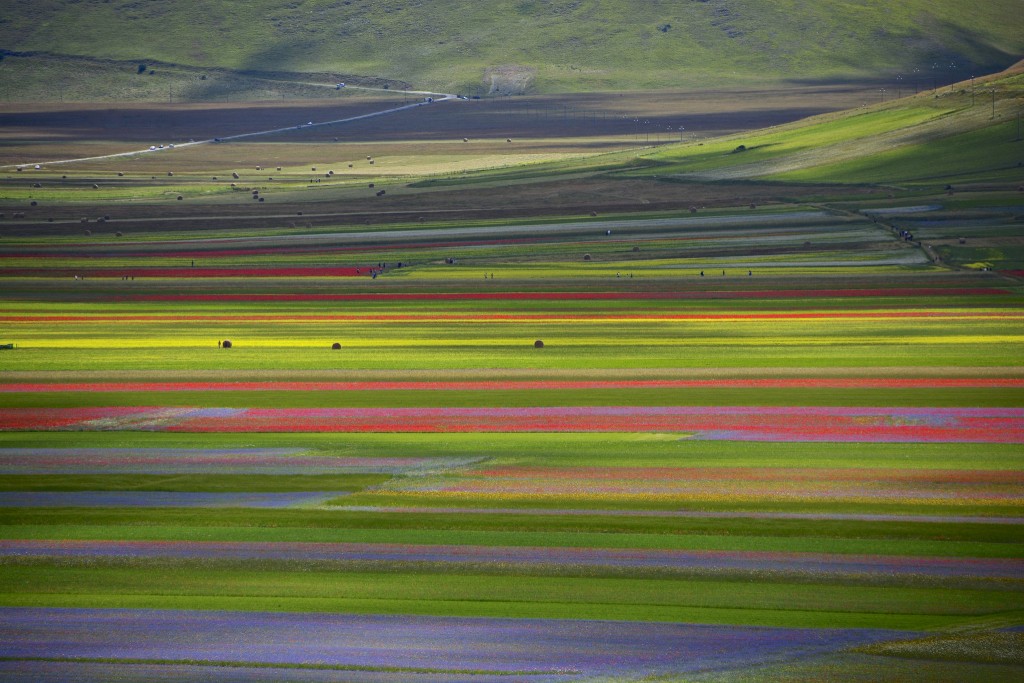
14 Comments
Jeff Terranova
September 26, 2015 at 4:36 pmExcellent Blog Post! Thanks for asking me to be a part of it.
Justin Hughes
September 26, 2015 at 9:41 pmThanks Jeff,
Glad you liked it, We had a lot of fun putting this one together, thanks again for the photos.
Adrian
September 27, 2015 at 8:51 pmNice set of photos and write-up!
Justin Hughes
September 27, 2015 at 9:00 pmThank’s Adrian.
Greg
September 29, 2015 at 7:15 amGreat post, very entertaining to read, with a lot of research!
Keep up the good work!
Justin Hughes
September 29, 2015 at 7:59 amThanks Greg
panc vis , holland
September 29, 2015 at 8:52 pmToo many pictures, not enough time !!! Impressive, a wonderful background for flower arranging!
Justin Hughes
September 30, 2015 at 6:56 amThanks Panc, we like to throw in a non-industry related blog every once and a while 🙂 but we will post more on Floral Design. Stay tuned!
Alexander J.E. Bradley
September 30, 2015 at 6:09 amWonderful article. It is a lot larger and substantial than I thought it would have been must have taken a while to compile. And I was happy to add my images of the Petite Ceinture for you to use. I had a question about the other places, the SS Ayrfield in Sydney, was it intentionally grown like that? Or did it just spring up by its self?
Cheers
Justin Hughes
September 30, 2015 at 6:54 amThanks Alexander, yes it took a lot of time to compile. Its a lot of fun though and we have a great writer (Kali) who takes care of the writing and the photographers like yourself who let us use their photo’s make it come together smoothly 🙂
The SS Ayrfield, as far as I am aware, sprouted mangroves naturally, likely via mangrove seeds in bird droppings.
Bill
October 2, 2015 at 2:07 pmGreat compilation! Thanks for offering to be part of it!
Justin Hughes
October 2, 2015 at 10:25 pmThanks for your cool photos!
Melodie K
February 3, 2016 at 9:33 pmGREAT STORIES in this post as well as history, tears (and humor, too . . . the “Bike Tree” comes to mind.) The amusement parks in Germany and Japan tie for my vote as “creepiest” sites ~ “childhood” and “abandonment” have never paired well together. Most beneficial outcome? The forest on the SS Ayrfield. Good read, Justin!
Justin Hughes
February 4, 2016 at 6:47 amThanks for the great feedback Melodie!
I have to agree with you on the creepiest ones being the theme parks. Once happy, exciting places, now just fading memories and overgrown structures.
Cheers
Justin